NBA 2025 Offseason Check-In: Golden State Warriors
Hoops Rumors is checking in on the 2025 offseason for all 30 NBA teams, recapping the summer’s free agent signings, trades, draft picks, departures, and more. We’ll take a look at each team’s offseason moves and consider what might still be coming before the regular season begins. Today, we’re focusing on the Golden State Warriors.
Free agent signings
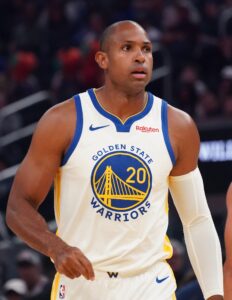 Jonathan Kuminga: Two years, $46,800,000. Second-year team option. Trade kicker (15%). Re-signed using Bird rights. Waived right to veto trade.
Jonathan Kuminga: Two years, $46,800,000. Second-year team option. Trade kicker (15%). Re-signed using Bird rights. Waived right to veto trade.- Al Horford: Two years, $11,654,250. Second-year player option. Trade kicker (15%). Signed using taxpayer mid-level exception.
- De’Anthony Melton: Two years, minimum salary. Second-year player option. Signed using minimum salary exception.
- Gary Payton II: One year, minimum salary. Signed using minimum salary exception.
- Seth Curry: One year, minimum salary. Non-guaranteed (Exhibit 9). Signed using minimum salary exception.
- LJ Cryer: One year, minimum salary. Non-guaranteed (Exhibit 10). Signed using minimum salary exception.
- Marques Bolden: One year, minimum salary. Non-guaranteed (Exhibit 10). Signed using minimum salary exception.
- Note: Bolden has since been waived.
- Ja’Vier Francis: One year, minimum salary. Non-guaranteed (Exhibit 10). Signed using minimum salary exception.
- Note: Francis has since been waived.
- Taevion Kinsey: One year, minimum salary. Non-guaranteed (Exhibit 10). Signed using minimum salary exception.
- Note: Kinsey has since been waived.
- Chance McMillian: One year, minimum salary. Non-guaranteed (Exhibit 10). Signed using minimum salary exception.
- Note: McMillian has since been waived.
- Jacksen Moni: One year, minimum salary. Non-guaranteed (Exhibit 10). Signed using minimum salary exception.
- Note: Moni has since been waived.
Trades
- Acquired the draft rights to Alex Toohey (No. 52 pick; from Suns) and the draft rights to Jahmai Mashack (No. 59 pick; from Rockets) in a seven-team trade in exchange for the draft rights to Koby Brea (No. 41 pick; to Suns).
- Acquired the draft rights to Will Richard (No. 56 pick) from the Grizzlies in exchange for the draft rights to Jahmai Mashack (No. 59 pick), the Warriors’ 2032 second-round pick (top-50 protected), and the draft rights to Justinian Jessup.
Draft picks
- 2-52: Alex Toohey
- Signed to two-way contract.
- 2-56: Will Richard
- Signed to four-year, $8,685,386 contract. First two years guaranteed. Third year non-guaranteed. Fourth-year team option.
Two-way signings
- Pat Spencer
- One year, $85,300 partial guarantee (will increase to $318,218 at start of regular season).
- Alex Toohey
- One year, $85,300 partial guarantee (will increase to $318,218 at start of regular season).
Note: The Warriors carried over Jackson Rowe on a two-way contract from 2024/25.
Departed/unsigned free agents
- Taran Armstrong (Dubai Basketball)
- Braxton Key (Grizzlies)
- Kevin Knox (Bulls)
- Kevon Looney (Pelicans)
Other roster moves
- Exercised team option on Gui Santos ($2,221,677).
- Exercised team option on Quinten Post ($1,955,377).
Salary cap situation
- Operating over the cap ($154.6MM) and below the luxury tax line ($187.9MM).
- Carrying approximately $205.3MM in salary.
- Hard-capped at $207,824,000.
- Two traded player exceptions frozen (largest worth $8,780,488).
The offseason so far
When we talk about what an NBA team did in the offseason, we usually refer to their “summer” moves. However, that’s a misnomer for the 2025 Warriors. As RealGM’s transaction log shows, after officially finalizing a pair of trades on July 6 that they’d agreed upon during June’s draft, Golden State didn’t complete another transaction until September 29 — the team officially signed 10 players that day (three of them were immediately waived).
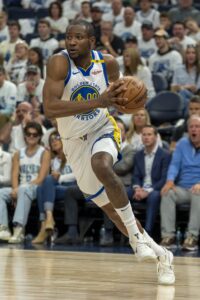 Obviously, Golden State’s front office wasn’t just taking a two-and-a-half month vacation. Jonathan Kuminga‘s restricted free agency was the reason for delay. The standoff between Kuminga and the Warriors became one of the offseason’s biggest stories after the first wave of free agency wrapped up in early July and ultimately took nearly three months to resolve, with the forward taking his decision almost right up to the October 1 deadline to accept a qualifying offer.
Obviously, Golden State’s front office wasn’t just taking a two-and-a-half month vacation. Jonathan Kuminga‘s restricted free agency was the reason for delay. The standoff between Kuminga and the Warriors became one of the offseason’s biggest stories after the first wave of free agency wrapped up in early July and ultimately took nearly three months to resolve, with the forward taking his decision almost right up to the October 1 deadline to accept a qualifying offer.
Technically, there was no rule preventing the Warriors from filling out the rest of their roster before they figured out what would happen with Kuminga. But that approach didn’t make sense for Golden State for a couple reasons.
For one, the Warriors were exploring the possibility of a sign-and-trade, discussing potential deals with the Suns and Kings. It didn’t sound like they ever gained any real traction with Phoenix, and Sacramento’s various offers – centered around draft assets plus either Malik Monk or the duo of Devin Carter and Dario Saric – didn’t hold much appeal either. But if either of those division rivals had increased their bid for Kuminga and made Golden State seriously consider a sign-and-trade, the team didn’t want to have the rest of its signings already locked in, since that could have resulted in significant roster imbalance.
More importantly, determining whether Kuminga would be back and how much he would be paid in 2025/26 dictated what the Warriors would be able to do with those other roster spots from a financial perspective. Kuminga accepting his $8MM qualifying offer would’ve resulted in a whole lot more cap flexibility than if he’d signed one of the team’s more lucrative multiyear proposals.
Conversely, if the Warriors had hard-capped themselves early in the offseason by, say, using the taxpayer mid-level exception to sign Al Horford, they would’ve risked another team giving Kuminga an offer sheet that they wouldn’t have been able to match without shedding salary. No team besides the Nets had cap room for most of the summer, and Brooklyn showed little to no interest in Kuminga, but as we saw with the Bucks and their Damian Lillard/Myles Turner moves, a team that wants to create cap space badly enough can typically find a way to do it.
So even though we knew for most of the summer what most of the Warriors’ roster moves would look like, those moves weren’t finalized until the fall. At that point, Kuminga accepted a two-year, $46.8MM deal that includes a second-year team option, no trade veto rights, and a 15% trade kicker; Horford received a two-year contract worth the full taxpayer mid-level exception with a second-year player option and a 15% trade kicker; De’Anthony Melton got a two-year, minimum-salary contract; Gary Payton II signed a one-year, veteran’s minimum deal; and second-round pick Will Richard received a rookie minimum salary on his four-year contract.
Horford, who will turn 40 next June, is one of the NBA’s oldest players, while Melton is still making his way back from the torn ACL that ended his 2024/25 season after just six games. But as long as they’re healthy, both players are excellent fits for this Warriors roster.
Horford is a savvy, smart defender who is capable of stretching the floor from the five spot. Melton can do a little bit of everything, and his versatile defense makes him an intriguing backcourt partner for Stephen Curry. In a very limited sample of 47 minutes before Melton’s ACL tear last season, lineups that included that Melton/Curry duo had a +38.4 net rating.
The big question is what happens with Kuminga. While it was a relief when his three-month free agency eventually came to an end, a two-year deal that includes a second-year option doesn’t exactly lock in his long-term future. Rather than making a decision on how the former lottery pick fits into their long-term plans, the Warriors simply postponed that decision for at least a few more months.
Kuminga will become trade-eligible on January 15 and it feels like there’s a very real chance he’s moved at some point during the three-week window between that date and the trade deadline — especially if Steve Kerr and his coaching staff continue to have trouble finding a consistent role for the 23-year-old that mutually benefits him and the team.
Up next
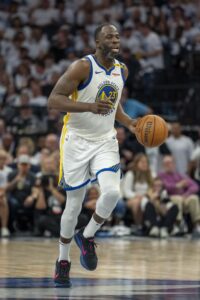 Seth Curry, who is on a non-guaranteed Exhibit 9 contract, has spent the preseason on the same roster as his superstar brother for the first time since he entered the league in 2013. However, the Warriors don’t have enough room below their second-apron hard cap to keep the younger Curry brother on their regular season roster — at least not yet. As of mid-November, Golden State would be able to fit a prorated minimum-salary contract under that hard cap and could reunite the Curry brothers.
Seth Curry, who is on a non-guaranteed Exhibit 9 contract, has spent the preseason on the same roster as his superstar brother for the first time since he entered the league in 2013. However, the Warriors don’t have enough room below their second-apron hard cap to keep the younger Curry brother on their regular season roster — at least not yet. As of mid-November, Golden State would be able to fit a prorated minimum-salary contract under that hard cap and could reunite the Curry brothers.
While it does sounds like the plan is to bring Seth back at some point, the Warriors may not do so immediately once they’re eligible to next month, since it would leave them with essentially no wiggle room below the second apron for the rest of 2025/26. I expect Seth to be a Warrior by season’s end, but the team could end up carrying a 14-man roster for at least a couple months.
Jackson Rowe, Pat Spencer, and Alex Toohey currently occupy Golden State’s two-way slots, but I wouldn’t be shocked if LJ Cryer, who is on an Exhibit 10 contract and has played well in the preseason, is converted to a two-way deal by Monday’s deadline. Rowe could be the odd man out, given that he was a holdover from last season and has had a very limited role this fall.
Finally, although Draymond Green and Trayce Jackson-Davis are currently eligible for veteran contract extensions, I’d be somewhat surprised if either player gets a new deal in the coming days. The Warriors barely have any money on their 2027/28 cap and would presumably prefer to maintain that flexibility for the time being. If Green or Jackson-Davis signs an extension at this point, it would probably have to be a short-term deal that includes little to no guaranteed money beyond ’26/27. The team would probably be happy to wait until 2026 to get serious about those negotiations.
NBA 2025 Offseason Check-In: Brooklyn Nets
Hoops Rumors is checking in on the 2025 offseason for all 30 NBA teams, recapping the summer’s free agent signings, trades, draft picks, departures, and more. We’ll take a look at each team’s offseason moves and consider what might still be coming before the regular season begins. Today, we’re focusing on the Brooklyn Nets.
Free agent signings
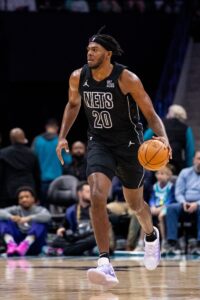 Day’Ron Sharpe: Two years, $12,500,000. Second-year team option. Re-signed using cap room. Waived right to veto trade.
Day’Ron Sharpe: Two years, $12,500,000. Second-year team option. Re-signed using cap room. Waived right to veto trade.- Ziaire Williams: Two years, $12,500,000. Second-year team option. Re-signed using cap room. Waived right to veto trade.
- Cam Thomas: One year, $5,993,172. Re-signed using Bird rights. Accepted qualifying offer.
- Fanbo Zeng: One year, minimum salary. Non-guaranteed (Exhibit 10). Signed using minimum salary exception.
- Yuri Collins: One year, minimum salary. Partially guaranteed ($85K). Signed using minimum salary exception.
- Note: Collins has since been waived.
- D’Andre Davis: One year, minimum salary. Partially guaranteed ($85K). Signed using minimum salary exception.
- Note: Davis has since been waived.
- David Muoka: One year, minimum salary. Partially guaranteed ($85K). Signed using minimum salary exception.
- Note: Muoka has since been waived.
- Terry Roberts: One year, minimum salary. Partially guaranteed ($25K). Signed using minimum salary exception.
- Tre Scott: One year, minimum salary. Partially guaranteed ($45K). Signed using minimum salary exception.
Trades
- Acquired either the Clippers’ 2026 second-round pick or the most favorable of the Celtics’, Pacers’, and Heat’s 2026 second-round picks (whichever is least favorable; from Rockets) and the Celtics’ 2030 second-round pick (from Rockets) in a seven-team trade in exchange for the draft rights to Adou Thiero (No. 36 pick; to Lakers).
- Acquired Terance Mann (from Hawks) and the draft rights to Drake Powell (No. 22 pick; from Hawks) in a three-team trade in exchange for cash ($1.1MM; to Celtics).
- Acquired Michael Porter Jr. and the Nuggets’ 2032 first-round pick from the Nuggets in exchange for Cameron Johnson.
- Acquired Haywood Highsmith and the Heat’s 2032 second-round pick from the Heat in exchange for the Nets’ 2026 second-round pick (top-55 protected).
- Acquired Kobe Bufkin from the Hawks in exchange for cash ($110K).
Draft picks
- 1-8: Egor Demin
- Signed to rookie scale contract (four years, $31,340,681).
- 1-19: Nolan Traore
- Signed to rookie scale contract (four years, $18,463,882).
- 1-22: Drake Powell
- Signed to rookie scale contract (four years, $16,723,991).
- 1-26: Ben Saraf
- Signed to rookie scale contract (four years, $14,806,815).
- 1-27: Danny Wolf
- Signed to rookie scale contract (four years, $14,384,199).
Two-way signings
- Tyson Etienne
- One year, $85,300 partial guarantee.
- E.J. Liddell
- One year, $85,300 partial guarantee.
Departed/unsigned free agents
- Reece Beekman (Magic)
- De’Anthony Melton (Warriors)
- D’Angelo Russell (Mavericks)
- Trendon Watford (Sixers)
Other roster moves
- Exercised team option on Jalen Wilson ($2,221,677; partial guarantee of $88,075).
- Exercised team option on Tyrese Martin ($2,191,897; non-guaranteed).
- Waived Dariq Whitehead (guaranteed $3,262,560 salary).
- Waived Keon Johnson ($217,614 partial guarantee).
- Waived Maxwell Lewis ($100,000 partial guarantee).
- Waived Drew Timme (non-guaranteed contract).
- Waived Tosan Evbuomwan (two-way contract).
Salary cap situation
- Operating below the cap ($154.6MM).
- Carrying approximately $141.2MM in salary.
- Hard-capped at $207,824,000.
- Approximately $13.4MM in cap room available.
- Full room exception ($8,781,000) available.
The offseason so far
The Nets ostensibly went into full rebuilding mode during the 2024 offseason. They traded away Mikal Bridges and entered that fall projected by oddsmakers to be the NBA’s worst team. But apparently no one told Jordi Fernandez that Brooklyn was supposed to be quite that bad. The new head coach led the Nets to nine wins in their first 19 games, getting nearly halfway to the team’s projected over/under win total (19.5) before November was over.
The Nets lost a little steam after that solid start, especially once reliable veterans like Dennis Schröder and Dorian Finney-Smith were traded away. But they remained competitive all season long, winning six of seven games during one stretch right before the All-Star break and finishing the year with a 26-56 record. It was bad, but not bad enough to earn a pick in the top half of the lottery. While the Nets entered June armed with four picks in the first round of the 2025 draft, none of those picks would be higher than their own selection at No. 8.
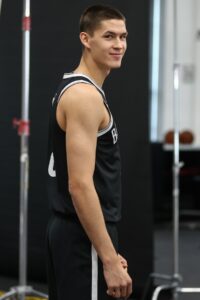 As the only team holding that many first-round picks and the only team with significant cap room available this offseason, it seemed obvious what sort of approach the still-rebuilding Nets would take to the summer. The general expectation was that they’d probably make a couple of their first-round picks while looking to roll at least one or two of them over to a future year, and that they’d use their cap room to take on unwanted contracts and continue stockpiling future draft assets in trades.
As the only team holding that many first-round picks and the only team with significant cap room available this offseason, it seemed obvious what sort of approach the still-rebuilding Nets would take to the summer. The general expectation was that they’d probably make a couple of their first-round picks while looking to roll at least one or two of them over to a future year, and that they’d use their cap room to take on unwanted contracts and continue stockpiling future draft assets in trades.
Half of that equation played out as expected. The Nets didn’t sign a single outside free agent to a guaranteed contract, instead using their cap space to take on salary in trades.
They acquired Terance Mann (owed $47MM over the next three seasons) from Atlanta along with a first-round pick. They swapped Cameron Johnson (two years and $44.1MM left) for Michael Porter Jr. (two years, $79.1MM) while getting a future unprotected future first-rounder from Denver in the process. And they took on Haywood Highsmith‘s expiring $5.6MM contract along with a future second-round pick in order to help get the Heat out of the tax.
While it won’t necessarily be easy to flip any of those players for positive value down the road, all three have proven to be solid rotation vets in the past and could absolutely rebuild their value in the wake of a down year (in Mann’s case) or an injury (for Porter and Highsmith). I wouldn’t be shocked if the Nets end up being able to extract a second-round pick in exchange for Highsmith a few months from now, for instance, after getting one simply to acquire him over the summer. The years left on Mann’s contract and Porter’s sizable cap hits will make it more difficult to acquire positive assets for them later this season or in a future year, but it’s not impossible.
The Nets’ use of their cap room offered no surprises, but their approach to the draft absolutely did. The first-round selection they acquired from Atlanta along with Mann was this year’s 22nd overall pick, giving Brooklyn a total of five first-rounders. And while they did reportedly explore trade options with several of those picks, the Nets ultimately kept all five of them, drafting Egor Demin, Nolan Traore, Drake Powell, Ben Saraf, and Danny Wolf at Nos. 8, 19, 22, 26, and 27, respectively.
That approach to the draft was, quite literally, unprecedented — no team in NBA history had ever used five first-round picks in the same draft before. Clubs typically don’t like bringing in too many rookies at once since it’s not considered the best developmental situation for a young player, but the Nets are taking their chances and putting a lot of faith in Fernandez and his staff.
It’s also hard not to read the strategy as general manager Sean Marks‘ way of saying: “That top-five pick we weren’t quite bad enough to get in 2025? We’re getting it in 2026.”
There are still a few veterans on this roster, including the three aforementioned trade acquisitions (Mann, Porter, and Highsmith), as well as starting center Nic Claxton. But Brooklyn will likely be the NBA’s youngest team, and getting to 26 wins again with this group will be a tall order for Fernandez. That’s why it came as no great shock when team owner Joe Tsai spoke recently about a “good pick” in 2026 being a top priority for the Nets and strongly hinted that the club was preparing to lose enough to position itself well in the draft lottery.
While Brooklyn didn’t add any outside free agents this offseason, the club did bring back three of its own — Day’Ron Sharpe and Ziaire Williams returned on matching two-year, $12.5MM contracts with second-year team options, while Cam Thomas accepted his $6MM qualifying offer as a restricted free agent.
The negotiations with that trio made two things clear: The Nets value the flexibility to potentially operate with significant cap room again next summer, and they don’t necessarily view any of those three players as long-term keepers. Because he signed his qualifying offer, Thomas has an implicit no-trade clause this season and can’t be moved without his approval, but Sharpe and Williams each waived his right to veto a trade, so either one – or both – could be on the move before February’s deadline.
Up next
The Nets have taken steps toward addressing their roster crunch by waiving Drew Timme, who was on a non-guaranteed contract, and Dariq Whitehead, a former first-round pick whose $3.26MM salary for 2025/26 was fully guaranteed.
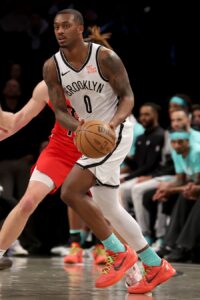 Timme’s release came as no real surprise despite his strong finish last season — he has played almost exclusively in the G League since going undrafted out of Gonzaga in 2023. Waiving Whitehead wasn’t quite as obvious, but injuries have derailed his NBA career so far, and the Nets are in position to eat some guaranteed salary due to their position relative to the cap (and the minimum salary floor).
Timme’s release came as no real surprise despite his strong finish last season — he has played almost exclusively in the G League since going undrafted out of Gonzaga in 2023. Waiving Whitehead wasn’t quite as obvious, but injuries have derailed his NBA career so far, and the Nets are in position to eat some guaranteed salary due to their position relative to the cap (and the minimum salary floor).
Brooklyn still has one move to make in the coming days, with 14 players on guaranteed contracts, Jalen Wilson on a partially guaranteed deal, and Tyrese Martin on a non-guaranteed pact. Usually in this scenario, the decision would come down to Wilson or Martin for financial reasons, but it might actually make sense for the Nets to keep both players and waive someone with a guaranteed salary — doing so would allow them to remain above the minimum salary floor without needing to make any additional moves.
With Whitehead no longer on the roster though, there’s not an obvious release candidate among those 14 players with guaranteed deals. Eight of them were either just drafted or re-signed this summer; Mann and Porter have too much guaranteed money left on their contracts; and starting center Nic Claxton obviously isn’t going to be cut. That leaves Highsmith, Noah Clowney, and Kobe Bufkin.
Waiving any of those three players likely wouldn’t have a major impact on the rotation, but the Nets just traded for Bufkin without getting anything else in the deal, which suggests they probably want to take a longer look at him. I haven’t gotten the sense that the team is prepared to give up on Clowney. Highsmith, meanwhile could bring back positive value later in the season if he gets fully healthy after undergoing offseason knee surgery, as noted above.
We’ll see what the Nets do — if either Wilson or Martin ends up as the odd man out, I wonder if the team would guarantee that player’s salary while cutting him in order to avoid falling back below the minimum floor. Staying above that threshold is important because it assures Brooklyn will get its share of the end-of-season payout from the NBA’s taxpaying teams.
The Nets also have an open two-way slot alongside Tyson Etienne and E.J. Liddell. Camp invitee Fanbo Zeng looks to me like the best candidate to fill it, but Timme could also return on a two-way deal if he clears waivers.
NBA 2025 Offseason Check-In: Sacramento Kings
Hoops Rumors is checking in on the 2025 offseason for all 30 NBA teams, recapping the summer’s free agent signings, trades, draft picks, departures, and more. We’ll take a look at each team’s offseason moves and consider what might still be coming before the regular season begins. Today, we’re focusing on the Sacramento Kings.
Free agent signings
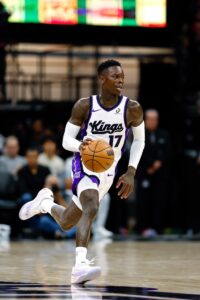 Dennis Schröder: Three years, $44,427,600. Third year partially guaranteed ($4,350,000). Signed using Bird rights and acquired via sign-and-trade from Pistons.
Dennis Schröder: Three years, $44,427,600. Third year partially guaranteed ($4,350,000). Signed using Bird rights and acquired via sign-and-trade from Pistons.- Doug McDermott: One year, minimum salary. Re-signed using minimum salary exception. Waived right to veto trade.
- Drew Eubanks: One year, minimum salary. Signed using minimum salary exception.
- Terence Davis: One year, minimum salary. Non-guaranteed (Exhibit 10). Re-signed using minimum salary exception. Waived right to veto trade.
- Jon Elmore: One year, minimum salary. Non-guaranteed (Exhibit 10). Signed using minimum salary exception.
- Note: Elmore has since been waived.
- Jameer Nelson Jr.: One year, minimum salary. Non-guaranteed (Exhibit 10). Signed using minimum salary exception.
- Note: Nelson has since been waived.
- Jaylin Williams: One year, minimum salary. Non-guaranteed (Exhibit 10). Signed using minimum salary exception.
- Note: Williams has since been waived.
- Dexter Dennis: One year, minimum salary. Non-guaranteed (Exhibit 10). Signed using minimum salary exception.
- Note: Dennis has since been waived.
Trades
- Acquired the draft rights to Nique Clifford (No. 24 pick) from the Thunder in exchange for the Spurs’ 2027 first-round pick (top-16 protected).
- Acquired Dennis Schröder (sign-and-trade) and either the Pistons’, Bucks’, or Knicks’ 2029 second-round pick (whichever is least favorable) from the Pistons in exchange for the Hornets’ 2026 second-round pick (top-55 protected).
- Acquired Dario Saric from the Nuggets in exchange for Jonas Valanciunas.
Draft picks
- 1-24: Nique Clifford
- Signed to rookie scale contract (four years, $15,769,801).
- 2-42: Maxime Raynaud
- Signed to three-year, $5,949,688 contract. First two years guaranteed. Third-year team option.
Two-way signings
- Dylan Cardwell
- Two years, non-guaranteed.
- Daeqwon Plowden
- One year, $75,000 partial guarantee.
- Isaiah Stevens
- Two years, $85,300 partial guarantee (will increase to $318,218 at start of regular season); second year partially guaranteed for maximum two-way protection amount (will increase to 50% at start of regular season).
Departed/unsigned free agents
- Jae Crowder (unsigned)
- Markelle Fultz (unsigned)
- Mason Jones (Perth Wildcats)
- Jake LaRavia (Lakers)
- Trey Lyles (Real Madrid)
Other roster moves
- Exercised team option on Keon Ellis ($2,301,587).
- Exercised team option on Isaac Jones ($1,955,377).
- Withdrew qualifying offer for Isaiah Crawford.
- Waived Terence Davis (non-guaranteed contract).
- Davis was later re-signed to a new Exhibit 10 contract.
Salary cap situation
- Operating over the cap ($154.6MM) and below the luxury tax line ($187.9MM).
- Carrying approximately $182.2MM in salary.
- Hard-capped at $195,945,000.
- Full non-taxpayer mid-level exception ($14,104,000) available.
- Full bi-annual exception ($5,134,000) available.
- Five traded player exceptions available (largest worth $4,968,600).
The offseason so far
Since winning 48 games and ending their 16-year postseason drought in 2022/23, the Kings have had a tougher go of it. They were eliminated in the play-in tournament in a competitive Western Conference in 2023/24, then fired former Coach of the Year Mike Brown after getting off to a disappointing start in ’24/25.
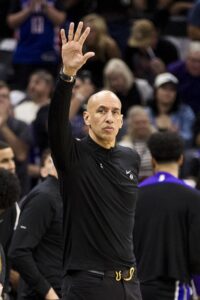 Interim head coach Doug Christie, who was promoted to the permanent role after the season, guided Sacramento to a winning record after taking over for Brown, but it wasn’t enough to get the team back to .500 or beyond the first game of the play-in tournament. And along the way, the Kings traded star point guard De’Aaron Fox after he made it clear he didn’t intend to sign a contract extension with the team.
Interim head coach Doug Christie, who was promoted to the permanent role after the season, guided Sacramento to a winning record after taking over for Brown, but it wasn’t enough to get the team back to .500 or beyond the first game of the play-in tournament. And along the way, the Kings traded star point guard De’Aaron Fox after he made it clear he didn’t intend to sign a contract extension with the team.
In addition to locking in Christie as their full-time head coach, the Kings also named a new head of basketball operations this spring, hiring veteran executive Scott Perry to replace former general manager Monte McNair. Perry was immediately thrown into the deep end in his first offseason in the position — Sacramento entered the summer capped out, without a first-round pick in the 2025 draft, and short on valuable trade chips.
Rather than aggressively trying to reshape the Kings’ roster with limited assets at his disposal, Perry took a relatively conservative approach during his first few months on the job. In the wake of the Fox trade, Sacramento badly needed a point guard, so the new GM went out and got one of the best available options in free agency, working out a three-year deal (only the first two years are guaranteed) with Dennis Schröder. While he was technically a sign-and-trade acquisition, Schröder’s contract is equivalent to the full non-taxpayer mid-level exception.
Schröder is on his eighth team since the start of the 2021/22 season and has been up and down in recent years. In 2024/25, for instance, he got off a great start in Brooklyn, but didn’t play well during a two-month stint in Golden State and wasn’t a whole lot better down the stretch in Detroit. The 32-year-old’s production earlier in his NBA career and on the international stage for the German national team suggest he’s capable of doing far more offensively than he did in 75 games last season (13.1 PPG, .406 FG%), but the Kings won’t be expecting miracles — they just wanted a solid, high-floor veteran to fill a gaping hole on their depth chart.
Besides adding a starting point guard, one of the Kings’ other goals this summer was to get back into the first round of the draft, which they were able to do at a pretty reasonable price. Sacramento acquired the No. 24 overall pick from the Thunder in exchange for a heavily (top-16) protected Spurs 2027 first-rounder that will turn into a pair of second-rounders if it doesn’t convey in ’27.
With that 24th overall pick, the Kings drafted Nique Clifford, a five-year college player who – at age 23 – looks like one of the most NBA-ready players in this year’s rookie class. You could make a case that a team coming off a sub-.500 season should have been looking to roll the dice on a younger prospect with more upside, but trying to find a potential rotation regular is a more realistic goal at No. 24 than hoping to hit paydirt on a future star. Clifford, an All-Summer League first teamer, absolutely looks capable of playing an NBA role.
Long rumored to be a Jonathan Kuminga suitor in a potential sign-and-trade, the Kings were reportedly willing to give up some combination of Malik Monk, Devin Carter, and/or Dario Saric, plus draft assets, in various iterations of offers to the Warriors. And while moving Zach LaVine was essentially a non-starter due to the size of his contract, DeMar DeRozan was also considered a possible offseason trade candidate.
However, Golden State wasn’t moved by Sacramento’s offers for Kuminga, and the Kings didn’t end up working out any other significant deals on the trade market besides their moves for Clifford and Schröder. The only other trade the front office made was a one-for-one swap of Jonas Valanciunas for Saric.
The Kings’ handling of Valanciunas was an example of what happens when a new head of basketball operations with his own ideas about what the roster should look like replaces one that was taking swings in the hopes of saving his job a few months earlier. After giving up two second-rounders to acquire Valanciunas in February, Sacramento traded him for a player who played just 210 total minutes last season and wasn’t effective in his limited role.
Saric is a possible bounce-back candidate and the trade was more about finances than on-court value — swapping out Valanciunas’ $10.4MM salary for Saric’s $5.4MM cap hit ensured the Kings were able to stay under the tax line.
Still, it resulted in a downgrade at the center spot behind Domantas Sabonis, where Saric, Drew Eubanks, and second-round pick Maxime Raynaud are in the mix as potential backups, and it may have been a missed opportunity for the Kings. After they agreed to that trade with Denver, word broke that Valanciunas wanted to return to Europe to play for Panathinaikos. If Sacramento had held onto the veteran center, perhaps the front office could’ve negotiated a buyout that would’ve removed most or all of his cap hit from its books and allowed the team to add a free agent with more value than Saric.
The rest of the Kings’ offseason moves were minor ones. Eubanks and sharpshooter Doug McDermott signed minimum-salary contracts, while Keon Ellis and Isaac Jones had their minimum-salary team options exercised. In general, the summer feels like it could be a prelude to more substantial roster changes in Sacramento, especially if the club continues to hover around or below .500 in 2025/26.
Up next
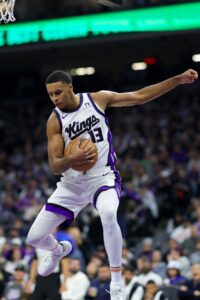 The Kings currently have 13 players on standard guaranteed contracts, plus Ellis on a non-guaranteed deal. That leaves one opening on the projected 15-man regular season roster. Terence Davis, who has played for Sacramento off and on since 2021 and is in camp on a non-guaranteed contract, could be the best candidate to fill it.
The Kings currently have 13 players on standard guaranteed contracts, plus Ellis on a non-guaranteed deal. That leaves one opening on the projected 15-man regular season roster. Terence Davis, who has played for Sacramento off and on since 2021 and is in camp on a non-guaranteed contract, could be the best candidate to fill it.
Still, I won’t be surprised if Davis is waived at the end of the preseason. The Kings don’t have a ton of wiggle room below the luxury tax line, so they may want to maintain the extra cap and roster flexibility that would come with leaving that 15th spot open for now.
It’s also worth noting that Russell Westbrook has been linked to Sacramento since the start of free agency and remains a candidate to end up with the team. I’ve gotten the sense that the Kings would need a clear-cut role – not just an open roster spot – to bring Westbrook aboard, so unless they trade one of their guards after having hung onto Monk and Carter through the offseason, a deal with the former MVP may not be in the cards.
Potential contract extensions for two of the Kings’ most promising young players – former No. 4 overall pick Keegan Murray and defensive stalwart Ellis – are probably more pressing issues in Sacramento than back-of-the-roster machinations. The team has until October 20 to work out a new deal with Murray, whereas Ellis will remain extension-eligible all season. Finding the right price point will be challenging in both cases.
Murray showed a ton of promise as a rookie in 2022/23, averaging 12.2 points per game and making 41.1% of his three-pointers, and he has improved defensively since then. However, his offensive numbers have stagnated — his shooting percentages of 44.4% from the field and 34.3% on three-pointers last season were career lows, as were his 13.0 points per 36 minutes. In order to invest heavily in Murray at this point, the Kings would have to be pretty confident in his ability to take another significant step forward within the next couple years.
As for Ellis, the former undrafted free agent has shown he’s capable of providing a little value offensively after initially establishing himself as a reliable point-of-attack defender. His 8.3 points per game and 43.3% three-point mark last season were career highs. Still, he can’t realistically be relied upon as a go-to play-maker or volume shooter, so the Kings will have to decide just how highly they value his defensive contributions.
NBA 2025 Offseason Check-In: Philadelphia 76ers
Hoops Rumors is checking in on the 2025 offseason for all 30 NBA teams, recapping the summer’s free agent signings, trades, draft picks, departures, and more. We’ll take a look at each team’s offseason moves and consider what might still be coming before the regular season begins. Today, we’re focusing on the Philadelphia 76ers.
Free agent signings
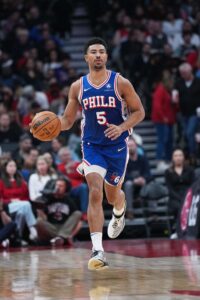 Quentin Grimes: One year, $8,741,209. Re-signed using Bird rights. Accepted qualifying offer.
Quentin Grimes: One year, $8,741,209. Re-signed using Bird rights. Accepted qualifying offer.- Justin Edwards: Three years, $7,076,338. Third-year team option. Re-signed using Non-Bird rights.
- Trendon Watford: Two years, minimum salary. Second-year team option. Signed using minimum salary exception.
- Eric Gordon: One year, minimum salary. Re-signed using minimum salary exception. Waived right to veto trade.
- Kyle Lowry: One year, minimum salary. Re-signed using minimum salary exception.
- Emoni Bates: One year, minimum salary. Non-guaranteed (Exhibit 10). Signed using minimum salary exception.
- Kennedy Chandler: One year, minimum salary. Non-guaranteed (Exhibit 10). Signed using minimum salary exception.
- Malcolm Hill: One year, minimum salary. Non-guaranteed (Exhibit 10). Signed using minimum salary exception.
- Igor Milicic: One year, minimum salary. Non-guaranteed (Exhibit 10). Signed using minimum salary exception.
- Saint Thomas: One year, minimum salary. Non-guaranteed (Exhibit 10). Signed using minimum salary exception.
- Marcus Bagley: One year, minimum salary. Non-guaranteed (Exhibit 10). Signed using minimum salary exception.
- Note: Bagley has since been waived.
- Jaylen Martin: One year, minimum salary. Non-guaranteed (Exhibit 10). Signed using minimum salary exception.
- Note: Martin has since been waived.
Trades
- None
Draft picks
- 1-3: VJ Edgecombe
- Signed to rookie scale contract (four years, $50,438,478).
- 2-35: Johni Broome
- Signed to four-year, $8,685,386 contract. First two years guaranteed. Third year non-guaranteed. Fourth-year team option.
Two-way signings
- Dominick Barlow
- One year, $85,300 partial guarantee (will increase to $318,218 at start of regular season).
- Hunter Sallis
- One year, $85,300 partial guarantee (will increase to $318,218 at start of regular season).
- Jabari Walker
- One year, $85,300 partial guarantee (will increase to $318,218 at start of regular season).
Departed/unsigned free agents
- Jared Butler (Suns)
- Jeff Dowtin Jr. (Maccabi Tel Aviv)
- Jalen Hood-Schifino (unsigned)
- Lonnie Walker IV (Maccabi Tel Aviv)
- Guerschon Yabusele (Knicks)
Other roster moves
- Waived Ricky Council IV (non-guaranteed contract).
- Waived Alex Reese (two-way contract).
Salary cap situation
- Operating over the cap ($154.6MM) and above the luxury tax line ($187.9MM).
- Carrying approximately $194.6MM in salary.
- No hard cap.
- Full non-taxpayer mid-level exception ($14,104,000) available.
- Full bi-annual exception ($5,134,000) available.
- Three traded player exceptions available (largest worth $7,975,000).
The offseason so far
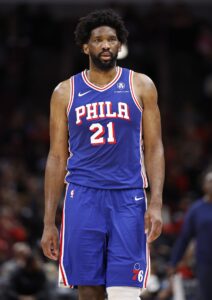 Coming off a massively disappointing year in which the Sixers entered the season as one of the NBA’s title favorites and finished with a 24-58 record, there was some speculation entering the 2025 offseason that the team might look to shake up its roster. President of basketball operations Daryl Morey has never been shy about taking big swings on the trade market, and stars Joel Embiid and Paul George – who combined to make 60 appearances in 2024/25 – suddenly looked like major liabilities on their long-term maximum-salary contracts.
Coming off a massively disappointing year in which the Sixers entered the season as one of the NBA’s title favorites and finished with a 24-58 record, there was some speculation entering the 2025 offseason that the team might look to shake up its roster. President of basketball operations Daryl Morey has never been shy about taking big swings on the trade market, and stars Joel Embiid and Paul George – who combined to make 60 appearances in 2024/25 – suddenly looked like major liabilities on their long-term maximum-salary contracts.
But the reasons the Sixers might have sought to move Embiid and/or George – age, health, and cap concerns – were the same reasons why there was no chance they’d be able to get fair value on the trade market for either player. Even if the club wanted to hit the reset button, it would mean giving up those two stars for pennies on the dollar, perhaps even having to attach assets to get a return of any real value for them.
So instead of a summer of change in Philadelphia, it was one of relative continuity. Neither Morey nor head coach Nick Nurse lost his job after last season’s 24-win showing. Embiid and George didn’t go anywhere. Potential free agents like Kelly Oubre Jr., Eric Gordon, Kyle Lowry, Andre Drummond, and Justin Edwards all either signed new contracts with the 76ers or picked up player options to return to the team.
Even Quentin Grimes‘ restricted free agency – which lasted a full three months and went all the way down to the wire on October 1, the deadline for him to accept his $8.74MM qualifying offer – ended in anticlimactic fashion, as Grimes ultimately did sign that QO. The Sixers reportedly weren’t very aggressive in their efforts to work out a longer-term agreement with the 25-year-old — their best offer to Grimes was said to be for about $39MM over four years, which was never going to get it done after he finished the season by averaging 21.9 points, 5.2 rebounds, and 4.5 assists per game in 28 outings for Philadelphia.
I was a little surprised that the Sixers didn’t try harder to avoid a scenario in which Grimes signed his qualifying offer, which gives him a no-trade clause for the season and lines him up for unrestricted free agency in 2026. But it seems like there were a couple primary reasons why the front office didn’t make it a priority to sign him to a multiyear contract.
For one, after they lucked out in the draft lottery by moving up to No. 3 and hanging onto their top-six protected first-round pick, the 76ers selected standout Baylor guard VJ Edgecombe, adding him to a backcourt that already features Tyrese Maxey and Jared McCain. Theoretically, Grimes can share the court with multiple guards, but at 6’4″, he’s a better fit at the two himself. Philadelphia’s front office may have felt that investing heavily in another guard didn’t make sense when Maxey, McCain, and Edgecombe project to be the club’s top options in the backcourt for years to come.
Getting Grimes back on the qualifying offer is also the most favorable outcome for Philadelphia’s 2025/26 cap, since any multiyear deal or one-year balloon offer would have started higher – and perhaps much higher – than $8.74MM. With that modest figure on their books, the Sixers are operating less than $7MM above the luxury tax line, giving them a potential path to duck below that threshold before the end of the season. Sending out Oubre at the trade deadline and replacing him with a free agent on a prorated minimum-salary contract would do the trick, for example.
You can certainly argue that maintaining the flexibility to get out of the tax shouldn’t be a top priority for a 76ers team that still ostensibly believes it can be a contender. But after the way last season played out, it’s understandable that ownership would want to see how the first two or three months of the season go before deciding whether it’s worth paying luxury tax penalties for this roster.
The Edgecombe pick and Grimes accepting his qualifying offer were the most significant developments of the Sixers’ offseason, but it’s worth highlighting the three-year deal they did with Edwards and the two-year contract they worked out with Trendon Watford, both of which are worth the minimum and feature a team option on the final season.
Edwards was effective in a limited role as a rookie last season, while Watford has been a somewhat underrated role player in Portland and Brooklyn in recent years. It wouldn’t be a shock if one or both of them earn regular minutes in the forward rotation for Philadelphia, and given the modest cost of their respective contracts, they won’t have to do a whole lot to justify the team’s investment.
Finally, while most of the Sixers’ departing free agents weren’t rotation players, the one notable exception was Guerschon Yabusele, one of last season’s most pleasant surprises in his first NBA season since 2018/19. Philadelphia reportedly only offered Yabusele a Non-Bird deal that would have started at 120% of his minimum salary.
Increasing that offer would have required using the taxpayer mid-level exception, which would’ve hard-capped the 76ers at the second tax apron and put them at risk of losing Grimes to an offer sheet. Even then, there’s no guarantee Yabusele would’ve taken Philadelphia’s offer over a similar one from the Knicks that was worth nearly the full taxpayer MLE. Losing Yabusele was unfortunate, but unless the club was OK with losing Grimes instead or had been able to shed salary elsewhere on the roster, it was an outcome that was hard to avoid.
Up next
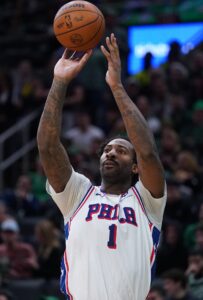 The Sixers are carrying just 14 players on standard contracts, but as we established above, they’re wary of going too much deeper into tax territory, so they’ll likely leave that 15th spot open to start the regular season.
The Sixers are carrying just 14 players on standard contracts, but as we established above, they’re wary of going too much deeper into tax territory, so they’ll likely leave that 15th spot open to start the regular season.
In two-way players Jabari Walker and Dominick Barlow, Philadelphia is carrying a pair of three-year veterans with 288 combined regular season appearances between them, which will help make up for the lack of a 15th man — either of those guys could play 10 or 15 minutes off the bench if needed. Undrafted rookie Hunter Sallis, the third Sixer on a two-way contract, is less likely to see action at the NBA level immediately.
Gordon and Drummond have been rumored as trade candidates throughout the offseason, but if a deal involving one of them goes down, it’s probably more likely to happen closer to the trade deadline. The emergence of second-year big man Adem Bona will be an interesting development to keep an eye on. If he emerges as a reliable backup center and Embiid can stay relatively healthy (a big if), Drummond would become more expendable.
Assuming the Sixers don’t make any preseason trades or unexpected roster changes, it should be a relatively quiet couple weeks in Philadelphia, since the team doesn’t have any extension-eligible players on its roster.
NBA 2025 Offseason Check-In: Memphis Grizzlies
Hoops Rumors is checking in on the 2025 offseason for all 30 NBA teams, recapping the summer’s free agent signings, trades, draft picks, departures, and more. We’ll take a look at each team’s offseason moves and consider what might still be coming before the regular season begins. Today, we’re focusing on the Memphis Grizzlies.
Free agent signings
 Santi Aldama: Three years, $52,500,000. Third-year team option. Re-signed using Bird rights.
Santi Aldama: Three years, $52,500,000. Third-year team option. Re-signed using Bird rights.- Ty Jerome: Three years, $27,660,150. Third-year player option. Trade kicker (15%). Signed using room exception.
- Cam Spencer: Four years, $10,396,518. Fourth-year team option. Re-signed using cap room.
- Jock Landale: One year, minimum salary. Signed using minimum salary exception.
- Tyler Burton: One year, minimum salary. Non-guaranteed (Exhibit 10). Signed using minimum salary exception.
- Braxton Key: One year, minimum salary. Non-guaranteed (Exhibit 10). Signed using minimum salary exception.
- Lawson Lovering: One year, minimum salary. Non-guaranteed (Exhibit 10). Signed using minimum salary exception.
Trades
- Acquired Kentavious Caldwell-Pope, Cole Anthony, the No. 16 pick in the 2025 draft, the Magic’s 2026 first-round pick (with swap rights; details below), the Magic’s 2028 first-round pick, the Magic’s 2030 first-round pick, and the right to swap first-round picks with the Magic in 2029 (top-two protected) from the Magic in exchange for Desmond Bane.
- Note: The Grizzlies will have the ability to swap the Magic’s 2026 first-round pick for the Suns’ 2026 pick (if the Wizards’ first-rounder lands outside of the top eight) or for the least favorable of the Suns’ and Wizards’ 2026 picks (if the Wizards’ first-rounder lands in the top eight).
- Note: Anthony was subsequently bought out.
- Acquired the draft rights to Cedric Coward (No. 11 pick) from the Trail Blazers in exchange for the draft rights to Yang Hansen (No. 16 pick), the Magic’s 2028 first-round pick, the Hawks’ 2027 second-round pick, and the Kings’ 2028 second-round pick.
- Acquired the Trail Blazers’ 2029 second-round pick and the right to swap their 2031 second-round pick for either the Pacers’ or Heat’s 2031 second-round pick (whichever is least favorable) from the Pacers in exchange for Jay Huff.
- Acquired the draft rights to Jahmai Mashack (No. 59 pick), the Warriors’ 2032 second-round pick (top-50 protected), and the draft rights to Justinian Jessup from the Warriors in exchange for the draft rights to Will Richard (No. 56 pick).
Draft picks
- 1-11: Cedric Coward
- Signed to rookie scale contract (four years, $26,345,863).
- 2-48: Javon Small
- Signed to two-way contract.
- 2-59: Jahmai Mashack
- Will play in G League.
Two-way signings
- PJ Hall
- One year, $85,300 partial guarantee (will increase to $318,218 at start of regular season).
- Olivier-Maxence Prosper
- One year, $85,300 partial guarantee (will increase to $318,218 at start of regular season).
- Javon Small
- Two years, $85,300 partial guarantee (will increase to $318,218 at start of regular season); second year partially guaranteed for maximum two-way protection amount (will increase to 50% at start of regular season).
Departed/unsigned free agents
- Marvin Bagley III (Wizards)
- Yuki Kawamura (Bulls)
- Luke Kennard (Hawks)
- Lamar Stevens (Paris Basketball)
Other roster moves
- Renegotiated Jaren Jackson Jr.‘s 2025/26 salary (from $23,413,395 to $35,000,000) and gave him a four-year, $205,000,000 veteran contract extension that begins in 2026/27. Includes fourth-year player option.
- Bought out and stretched Cole Anthony (gave up $2,000,000 of $13,100,000 salary).
- Waived Zyon Pullin (two-way contract).
Salary cap situation
- Operating over the cap ($154.6MM) and below the luxury tax line ($187.9MM).
- Carrying approximately $171.5MM in salary.
- Hard-capped at $195,945,000.
The offseason so far
It has been a fascinating few years in Memphis, where the Grizzlies looked like one of the NBA’s best up-and-coming young teams as they won 56 games in 2021/22 and 51 more a year later. Ja Morant‘s off-court behavior and a series of injuries derailed the 2023/24 season, but the team seemed well on its way to picking up where it left off in ’24/25, running out to a 35-16 start and holding the No. 2 seed in the West at the trade deadline.
However, a 13-18 finish resulted in a late-season coaching change – Tuomas Iisalo replaced Taylor Jenkins – and some pretty significant offseason roster moves, creating some uncertainty about what exactly this team’s ceiling looks like going forward.
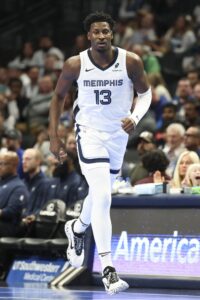 Let’s start with what, in some ways, was the most important decision of the Grizzlies’ offseason — with former Defensive Player of the Year Jaren Jackson Jr. entering a contract year and Memphis unable to offer him a market-value deal via a standard veteran extension, the team opted to dip under the cap in order to renegotiate his contract. Using that newly created cap room, the team was able to give Jackson an immediate raise of nearly $12MM for 2025/26, then extend him off his new $35MM salary. The end result was nearly $217MM in new money for Jackson, who is now locked up through at least the 2028/29 season, with a player option for ’29/30.
Let’s start with what, in some ways, was the most important decision of the Grizzlies’ offseason — with former Defensive Player of the Year Jaren Jackson Jr. entering a contract year and Memphis unable to offer him a market-value deal via a standard veteran extension, the team opted to dip under the cap in order to renegotiate his contract. Using that newly created cap room, the team was able to give Jackson an immediate raise of nearly $12MM for 2025/26, then extend him off his new $35MM salary. The end result was nearly $217MM in new money for Jackson, who is now locked up through at least the 2028/29 season, with a player option for ’29/30.
The Grizzlies made it clear with their actions that Jackson is one of the cornerstones they intend to build around for years to come. And they essentially confirmed that Morant – despite some poor off-court decisions a couple years ago and some nagging health issues since then – still falls into that category as well when they dealt Desmond Bane to Orlando in one of the biggest trades of the NBA offseason.
As I observed when I previewed Memphis’ offseason in early June, as good as Bane is, he had become a logical trade candidate as long as he was the third-most important player on this roster. His near-max deal was going to make it difficult for the Grizzlies to build a quality supporting cast around Morant and Jackson, especially with Jackson and some of the team’s younger players about to get more expensive.
I suggested at the time that it might make sense from a roster-building perspective for the Grizzlies to split up Bane’s salary slot into two or three players, which is essentially what the team did. The package Memphis got from the Magic was heavy on draft picks, and one of the two players sent to the Grizzlies in the trade (Cole Anthony) was bought out a few weeks later. But Kentavious Caldwell-Pope is a logical (albeit older and less dynamic) replacement for Bane in the lineup, and the Grizzlies used a couple of the first-round picks they acquired from Orlando to trade up in this June’s draft to nab forward Cedric Coward.
It’s a major roll of the dice for the Grizzlies, who paid a significant price (an unprotected future first-rounder and two second-rounders) to move up from No. 16 to No. 11 for Coward after he was limited to just six games in his senior college season due to a shoulder injury.
Coward, who spent his freshman year at Willamette University in Oregon and then played two seasons for Eastern Washington before transferring to Washington State, didn’t have a huge body of work against high-level college competition, but he was reportedly a standout during the pre-draft process — and, at age 22, he could be more ready than most first-rounders to contribute right away at the NBA level.
It would be misguided to believe that Coward is capable of immediately giving the Grizzlies what last year’s version of Bane did, but the front office clearly has high hopes for what the rookie can become. He’ll also be on a very team-friendly contract for at least the next four seasons, giving the team the flexibility to invest more heavily in some other role players who will complement Morant and Jackson.
One of those players is big man Santi Aldama, a notable 2025 restricted free agent who didn’t have to wait multiple months for a new deal. The Grizzlies and Aldama agreed to terms early in the summer on a three-year, $52.5MM contract that includes a third-year team option. It looks like a pretty good arrangement for both sides after Aldama enjoyed the best season of his career in 2025/26. He gets a nice payday after earning just $10.2MM in his first four NBA seasons, while Memphis has an out after just two years in case the 24-year-old doesn’t continue improving.
The Grizzlies also worked out a new multiyear agreement with Cam Spencer, who spent his rookie season on a two-way contract with the club. Spencer’s numbers – 4.2 points and 1.4 assists per game in 25 appearances – certainly don’t jump off the page, but he gave Memphis solid minutes when given the opportunity, and the front office hasn’t been shy about investing in longer-term, team-friendly deals for young players who show some promise. Spencer’s new four-year contract is fully guaranteed for three years, but is worth just $10.4MM overall, so it’s quite low-risk.
With Jackson and Spencer signed using cap room and Aldama’s Bird rights used to eventually complete his deal, the Grizzlies had the opportunity to use the $8.78MM room exception to go shopping for an outside free agent. They ultimately used that entire exception to land Cavaliers guard Ty Jerome, signing him to a three-year, $27.66MM contract. While the deal includes player-friendly terms like a third-year player option and a 15% trade kicker, it’s still a nice get for Memphis, given that Jerome was widely viewed as a strong candidate for a mid-level type contract in the neighborhood of $12-14MM per year.
The combined cap hits for Jerome, Caldwell-Pope, and Coward in 2025/26 are almost exactly equivalent to what Bane will earn in Orlando, and the Grizzlies will hope that the various skills those three players bring to the table can help fill the significant hole created by Bane’s exit. Jerome has his limitations, especially on the defensive end, but he showed last season that he can be a valuable scorer, shooter, and secondary play-maker.
Finally, it’s worth highlighting one more minor move made by the Grizzlies. As part of their efforts to clear cap room for Jackson’s renegotiation, they sent center Jay Huff to Indiana in exchange for a second-round pick and a second-round swap. Huff, a rim-protecting big man who can stretch the floor on offense, had flashed some upside in limited minutes in Memphis and could be primed for a larger role in Indiana.
While I certainly don’t expect Huff to become a star, it’s possible that move could backfire to some extent on a Grizzlies team that will likely start the season without Jackson, Zach Edey, and Brandon Clarke available in the frontcourt due to injuries. Minimum-salary free agent addition Jock Landale took Huff’s spot on the roster and could become the team’s opening night starting center by default.
Up next
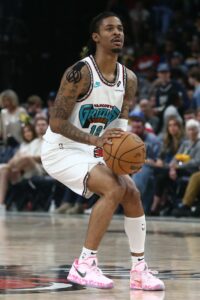 The Grizzlies have 15 players on guaranteed salaries and three on two-way deals, so their regular season roster looks pretty much set. Two-way moves are always a possibility during the preseason, but Javon Small was a 2025 second-round pick who signed a two-year contract, Olivier-Maxence Prosper is a former first-rounder who could play his way into Memphis’ rotation, and PJ Hall could provide valuable frontcourt depth early in the season until the Grizzlies gets healthier.
The Grizzlies have 15 players on guaranteed salaries and three on two-way deals, so their regular season roster looks pretty much set. Two-way moves are always a possibility during the preseason, but Javon Small was a 2025 second-round pick who signed a two-year contract, Olivier-Maxence Prosper is a former first-rounder who could play his way into Memphis’ rotation, and PJ Hall could provide valuable frontcourt depth early in the season until the Grizzlies gets healthier.
As for potential preseason contract extensions, the Grizzlies have no players eligible for rookie scale extensions, but there are a few who could theoretically get veteran deals, starting with Morant.
While I do view the Bane trade as a vote of confidence in Morant, I’d be shocked if an extension happened this year. The former No. 2 overall pick is coming off a down year and still has three seasons left on his current deal. If the coming season goes well, the two sides could open negotiations in earnest during the 2026 offseason.
Clarke and John Konchar are also extension-eligible until October 20, but neither one looks like a legitimate extension candidate at this point. Clarke just underwent a procedure on his knee, while Konchar’s role declined significantly last season. Both players have two years left on their current contracts and seem more likely to be traded than extended at this point — that could change if they play well in 2025/26.
NBA 2025 Offseason Check-In: Milwaukee Bucks
Hoops Rumors is checking in on the 2025 offseason for all 30 NBA teams, recapping the summer’s free agent signings, trades, draft picks, departures, and more. We’ll take a look at each team’s offseason moves and consider what might still be coming before the regular season begins. Today, we’re focusing on the Milwaukee Bucks.
Free agent signings
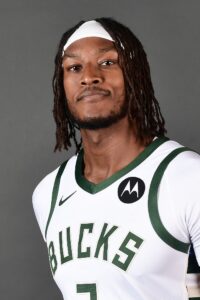 Myles Turner: Four years, $108,868,482. Fourth-year player option. Trade kicker (15%). Signed using cap room.
Myles Turner: Four years, $108,868,482. Fourth-year player option. Trade kicker (15%). Signed using cap room.- Bobby Portis: Three years, $43,564,242. Third-year player option. Re-signed using Bird rights.
- Ryan Rollins: Three years, $12,000,000. Third-year player option. Re-signed using Early Bird rights.
- Kevin Porter Jr.: Two years, $10,524,700. Second-year player option. Re-signed using room exception. Waived right to veto trade.
- Gary Trent Jr.: Two years, $7,579,065. Second-year player option. Re-signed using Non-Bird rights. Waived right to veto trade.
- Gary Harris: Two years, minimum salary. Second-year player option. Signed using minimum salary exception.
- Taurean Prince: Two years, minimum salary. Second-year player option. Re-signed using minimum salary exception. Waived right to veto trade.
- Jericho Sims: Two years, minimum salary. Second-year player option. Re-signed using minimum salary exception.
- Thanasis Antetokounmpo: One year, minimum salary. Signed using minimum salary exception.
- Cole Anthony: One year, minimum salary. Signed using minimum salary exception.
- Chris Livingston: One year, minimum salary. Re-signed using minimum salary exception. Waived right to veto trade.
- Amir Coffey: One year, minimum salary. Non-guaranteed (Exhibit 9). Signed using minimum salary exception.
- Cormac Ryan: One year, minimum salary. Non-guaranteed (Exhibit 10). Signed using minimum salary exception.
Trades
- Acquired Vasilije Micic from the Hornets in exchange for Pat Connaughton, the Bucks’ 2031 second-round pick, and the Bucks’ 2032 second-round pick.
- Note: Micic was subsequently bought out.
Draft picks
- 2-47: Bogoljub Markovic
- Will play overseas with Mega Basket.
Two-way signings
- Mark Sears
- One year, $85,300 partial guarantee.
Note: The Bucks carried over Jamaree Bouyea and Pete Nance on two-way contracts from 2024/25
Departed/unsigned free agents
- Brook Lopez (Clippers)
- Stanley Umude (Spurs)
Other roster moves
- Waived and stretched Damian Lillard ($112,583,016 guaranteed salary over two years)
- Bought out and stretched Vasilije Micic (gave up $6,109,150 of $8,109,150 salary).
Salary cap situation
- Operating over the cap ($154.6MM) and below the luxury tax line ($187.9MM).
- Carrying approximately $174.1MM in salary.
- No hard cap.
- Portion of room exception ($3,647,000) available.
The offseason so far
NBA free agency has lost some of its luster in recent years, with many of the league’s best players agreeing to extensions well before they hit the open market, while most of the top players who do become free agents simply signing new contracts with their current teams. This offseason, for example, nine of the top 10 free agents on our top-50 list re-signed with their previous clubs.
The one exception in that top 10? Longtime Pacers center Myles Turner, who left Indiana after a decade with the franchise to sign a four-year contract with the rival Bucks.
Turner’s deal with the Bucks was one of the only truly shocking developments of NBA free agency. The veteran big man had been widely expected to stick with the Pacers after they got within one win of a championship, while Milwaukee entered the offseason operating well over the cap and not particularly well positioned to pursue a top free agent.
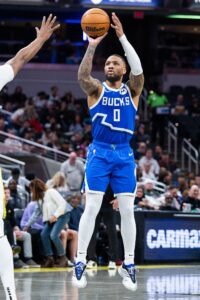 But the Bucks’ front office had plenty of reason to be bold this summer. The team had just been eliminated in the first round of the playoffs for a third straight year, and star point guard Damian Lillard suffered an Achilles tear in the postseason that would almost certainly sideline him for the entire 2025/26 season. Given that Giannis Antetokounmpo had spoke openly in the past about wanting to make sure he can keep legitimately competing for titles, Milwaukee couldn’t afford to essentially waste another year of the star forward’s prime waiting for Lillard to return.
But the Bucks’ front office had plenty of reason to be bold this summer. The team had just been eliminated in the first round of the playoffs for a third straight year, and star point guard Damian Lillard suffered an Achilles tear in the postseason that would almost certainly sideline him for the entire 2025/26 season. Given that Giannis Antetokounmpo had spoke openly in the past about wanting to make sure he can keep legitimately competing for titles, Milwaukee couldn’t afford to essentially waste another year of the star forward’s prime waiting for Lillard to return.
Trading Lillard would have been an option for the Bucks, but with two years and $112.6MM left on his contract, the 35-year-old would have had limited trade value even if he were fully healthy — recovering from an Achilles tear, he was very much a negative asset, meaning that even if Milwaukee attached its lone tradable first-round pick (either 2031 or 2032) to him, acquiring an impact player for Lillard would have been a very tall order.
Lillard’s diminished value – combined with the fact that working out a sign-and-trade with a division rival for Turner would’ve been difficult, if not impossible – spurred the Bucks to go to extreme measures to create the cap room necessary to sign the longtime Pacer. A series of transactions was necessary in order to open up that room, including trading for Vasilije Micic for the sole purpose of buying him out, but the major move that ultimately got them over the goal line was using the stretch provision on Lillard’s contract, spreading the $112.6MM still owed to him across the next five seasons and reducing his 2025/26 cap charge by more than $31MM.
It was an unprecedented move (at least until a couple weeks later, when the Suns pulled off something similar with Bradley Beal), but one that made sense for a Bucks team desperate not just to head off a possible Antetokounmpo trade request but to get the two-time MVP some help while he’s still at the top of his game.
Sure, it’s not ideal that Milwaukee will still be carrying $22.5MM annually on its cap for Lillard three or four years from now, but it was a necessary evil to upgrade the roster in the short term. And if this gambit backfires and the team has to shift into rebuilding mode a couple years from now, those dead-money cap hits wouldn’t be as significant an impediment — just look at the current Nets, who have been trying to spend enough in recent weeks to simply reach the minimum salary floor.
This still isn’t a roster without holes, but in Turner, the Bucks now have a younger, more athletic, and more versatile version of Brook Lopez, the team’s former starting center who left for the Clippers this summer. Lopez’s ability to stretch the floor on offense and to protect the rim on defense – two things Turner can do very well too – were major factors in Milwaukee’s success in recent years.
And because the Bucks didn’t have to trade a first-round pick to move off of Lillard’s massive contract or to acquire Turner, they still have some trade ammunition in their back pocket to search for a mid-season deal that would further upgrade the roster.
After going under the cap and then using up all their room to sign Turner, the Bucks had limited flexibility to fill out the rest of their squad this offseason, but they took advantage of their remaining rights on their own free agents while also making a handful of savvy minimum-salary signings.
Big man Bobby Portis was re-signed using his Bird rights; point guards Ryan Rollins and Kevin Porter Jr. were brought back using their Early Bird rights and the room exception, respectively; Gary Trent Jr. returned to Milwaukee on a Non-Bird contract; and Gary Harris, Taurean Prince, Jericho Sims, Cole Anthony, Chris Livingston, and Thanasis Antetokounmpo all received minimum-salary deals from the Bucks.
Many of those players were members of last year’s team that was ousted in the first round of the postseason, but there’s a belief in Milwaukee that younger players like Rollins and Porter are capable of taking another step forward in regular, full-season roles, and that newcomers like Anthony, Harris, and especially Turner can help make the Bucks a more well-rounded team. We’ll see if that belief pays off.
Up next
The Bucks are carrying 15 players on fully guaranteed salaries for 2025/26, but they also have Andre Jackson Jr. on a partially guaranteed deal and Amir Coffey – a productive rotation player for the Clippers last season – on a non-guaranteed Exhibit 9 deal. In other words, those 15 roster spots likely aren’t set in stone yet, a fact that general manager Jon Horst acknowledged on media day earlier this week.
If the Bucks do trade or waive someone with a guaranteed contract in order to clear space to hang onto Jackson and/or Coffey, the players most at risk would likely be 2023 second-round pick Livingston and 2024 second-rounder Tyler Smith. Neither Livingston nor Smith has earned regular rotation minutes yet, and neither one is owed guaranteed money beyond this season.
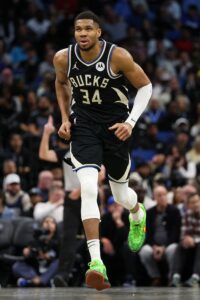 If we were evaluating the roster purely based on projected performance, Thanasis would be a logical release candidate as well, but it’s hard to imagine the Bucks waiving Giannis’ brother while they’re doing all they can to convince him to remain in Milwaukee long-term.
If we were evaluating the roster purely based on projected performance, Thanasis would be a logical release candidate as well, but it’s hard to imagine the Bucks waiving Giannis’ brother while they’re doing all they can to convince him to remain in Milwaukee long-term.
Speaking of which, while it was good news that Giannis didn’t seek a change of scenery this summer, his comments on media day – confirming he weighed his options during the offseason and saying he didn’t remember a meeting with governor Wes Edens in which he reaffirmed his commitment to Milwaukee – probably won’t shut down speculation about his long-term future with the organization.
As long as no trade request comes, the front office likely won’t be all that bothered about outside chatter, but Antetokounmpo’s remarks were a far cry from fellow NBA MVP Nikola Jokic talking about his plan to “be with the Nuggets forever.” The simplest way to ensure Giannis conveys a similar sentiment a year from now will be for the Bucks to win.
With that in mind, it will be interesting to see what happens with Kyle Kuzma this season. The veteran forward scored a career-low 14.8 points per game and made just 30.7% of his three-pointers in 2024/25. He’ll need to be better for Milwaukee to have a shot at contention in ’25/26. Even if he is, Kuzma could be a prime trade candidate, since he’s one of the only players on the roster earning more than about $5MM this season.
Kuzma is eligible for a contract extension before the season begins, but I don’t expect him to get a new deal at this point — it’s more likely we hear mid-season chatter about the Bucks gauging the trade value of Kuzma and their lone tradable first-round pick.
The more logical extension candidate on the roster is fourth-year sharpshooter A.J. Green, who will remain eligible for a new deal all season long if he doesn’t reach an agreement within the next few weeks. The 26-year-old more than doubled his minutes per game to 22.7 last season while registering a career-high three-point percentage of 42.7%.
Although Green’s counting stats (7.4 points and 2.4 rebounds per game) don’t jump off the page, he’s a reliable shooter and solid defender who fits well next to Antetokounmpo. As long as the price isn’t exorbitant, working out a new contract with him would make a lot of sense for Milwaukee.
NBA 2025 Offseason Check-In: Utah Jazz
Hoops Rumors is checking in on the 2025 offseason for all 30 NBA teams, recapping the summer’s free agent signings, trades, draft picks, departures, and more. We’ll take a look at each team’s offseason moves and consider what might still be coming before the regular season begins. Today, we’re focusing on the Utah Jazz.
Free agent signings
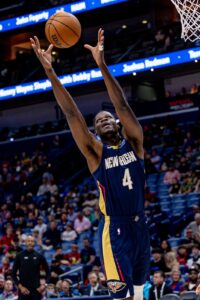 Mo Bamba: One year, minimum salary. Non-guaranteed (Exhibit 10). Signed using minimum salary exception.
Mo Bamba: One year, minimum salary. Non-guaranteed (Exhibit 10). Signed using minimum salary exception.- Steven Crowl: One year, minimum salary. Non-guaranteed (Exhibit 10). Signed using minimum salary exception.
- Matthew Murrell: One year, minimum salary. Non-guaranteed (Exhibit 10). Signed using minimum salary exception.
Trades
- Acquired the draft rights to Walter Clayton (No. 18 pick) from the Wizards in exchange for the draft rights to Will Riley (No. 21 pick), the No. 43 pick in the 2025 draft, either the Heat’s or Pacers’ 2031 second-round pick (whichever is most favorable), and the Jazz’s 2032 second-round pick.
- Acquired Jusuf Nurkic from the Hornets in exchange for Collin Sexton and either the Jazz’s or Clippers’ 2030 second-round pick (whichever is most favorable).
- Acquired Kyle Anderson (from Heat), Kevin Love (from Heat), the Clippers’ 2027 second-round pick (from Clippers), and cash ($2.5MM; from Clippers) in a three-team trade in exchange for John Collins (to Clippers).
- Acquired Georges Niang, either the Celtics’ or Magic’s 2027 second-round pick (whichever is most favorable) and either the Celtics’ or Cavaliers’ 2031 second-round pick (whichever is most favorable) from the Celtics in exchange for RJ Luis (two-way).
Draft picks
- 1-5: Ace Bailey
- Signed to rookie scale contract (four years, $41,209,782).
- 1-18: Walter Clayton
- Signed to rookie scale contract (four years, $19,324,472).
- 2-53: John Tonje
- Signed to two-way contract.
Two-way signings
- John Tonje
- One year, $85,300 partial guarantee (will increase to $318,218 at start of regular season).
- Oscar Tshiebwe
- One year, $85,300 partial guarantee (will increase to $318,218 at start of regular season).
Note: The Jazz carried over Elijah Harkless on a two-way contract from 2024/25; they also signed RJ Luis to a two-year, two-way contract, but traded him to the Celtics later in the offseason.
Departed/unsigned free agents
- Micah Potter (Spurs)
Other roster moves
- Bought out Jordan Clarkson (gave up $3,441,016 of $14,092,577 salary).
- Waived Johnny Juzang (non-guaranteed contract).
- Waived KJ Martin (non-guaranteed contract).
- Waived Jaden Springer (non-guaranteed contract).
Salary cap situation
- Operating over the cap ($154.6MM) and below the luxury tax line ($187.9MM).
- Carrying approximately $171.5MM in salary.
- Hard-capped at $195,945,000.
The offseason so far
At his introductory press conference as the Jazz’s new president of basketball operations in June, Austin Ainge was asked about the team’s tanking efforts during the second half of the 2024/25 season and unequivocally stated that you “won’t see that” again in ’25/26.
However, as I wrote at the time, Ainge’s comments didn’t seem to point toward a team ready to add win-now help to try to move up the standings. The tanking he was specifically ruling out was the kind that involves manipulating players’ minutes — for instance, not using optimal lineups during crunch-time situations, or holding veterans out of games due to injuries that they’d typically play through if the team were in the playoff mix.
But if we define tanking more broadly as a front office not trying all that hard to build a roster capable of winning games in the short term, the 2025/26 Jazz will absolutely fall under that umbrella. And you can make a strong case that’s the right play for the organization in the long term.
After all, the Jazz will have to send their 2026 first-round pick to the Thunder if it lands outside the top eight. If it lands inside the top eight, Utah would keep that first-rounder and would no longer owe Oklahoma City any draft pick. For a team that still doesn’t have a surefire long-term franchise player on its roster, taking one more shot at a high lottery choice makes a lot more sense than pushing for a play-in spot and potentially giving up that first-round selection.
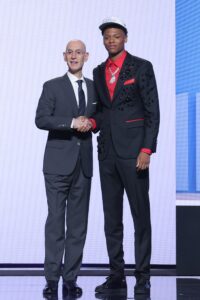 So, despite entering the offseason with one of the NBA’s most favorable salary cap situations, the Jazz essentially sat out of free agency. They completed three Exhibit 10 signings, including one with former lottery pick Mo Bamba, but didn’t hand out a single dollar of guaranteed money to a free agent.
So, despite entering the offseason with one of the NBA’s most favorable salary cap situations, the Jazz essentially sat out of free agency. They completed three Exhibit 10 signings, including one with former lottery pick Mo Bamba, but didn’t hand out a single dollar of guaranteed money to a free agent.
And while the Jazz hung onto forward Lauri Markkanen and center Walker Kessler, the two most valuable established building blocks on the roster, they spent the summer purging the roster of most of their other productive veterans.
Jordan Clarkson, who won a Sixth Man of the Year award in 2021 and had averaged 17.5 points per game since being traded to the Jazz in 2019, was bought out of his expiring $14.1MM contract, clearing a path for him to sign a minimum-salary deal with the Knicks.
Collin Sexton, the team’s third-leading scorer in 2024/25 with an average of 18.4 points per game on an efficient .480/.406/.865 shooting line, was traded to Charlotte along with a future “most favorable” second-round pick in exchange for Jusuf Nurkic.
That deal with the Hornets was a surprising one from a value perspective, since Sexton and Nurkic are on nearly identical expiring contracts in ’25/26 and Nurkic’s playing time and production dropped off last season. Given that Sexton was Utah’s most valuable guard in ’24/25, it’s hard to view the trade as anything other than a gambit to open up more playing time for the club’s backcourt prospects. And if the development process for those younger guards is up and down, resulting in fewer Jazz wins in the short term, that’s probably just fine with the front office.
The Jazz also sent John Collins to the Clippers in a three-team trade that netted them Kyle Anderson, Kevin Love, a second-round pick, and cash.
It was a relatively modest return for Collins, who put up 19.0 points and 8.2 rebounds per game on .527/.399/.848 shooting last season, since his $26.6MM salary made him a little tricky to move. But at least in this case, Utah created significant cap savings (Anderson and Love combine to earn just $13.4MM) and acquired a future second-rounder instead of giving one up. It also wouldn’t be shocking if the Jazz are able to flip Anderson for positive value at the trade deadline, though Love will likely just be waived or bought out at some point.
Utah’s one trade for a veteran involved forward Georges Niang, a sharpshooter who played some of the best basketball of his career in Atlanta during the second half of last season. The Jazz acquired him from Boston, though that deal was more about the two second-round picks attached to Niang than the player himself — like Anderson, he’s a candidate to be flipped before February’s deadline if Utah can get a decent return.
While vets like Nurkic, Anderson, Love, and Niang are unlikely to have long-term stays in Utah, the Jazz did add a pair of players on draft night that they hope will remain in the organization for years to come. The team used the fifth overall pick to draft Rutgers forward Ace Bailey, then traded up to No. 18 to nab Florida guard Walter Clayton.
The front office deserves kudos for rolling the dice on Bailey, whose camp was reportedly pushing hard for him to end up elsewhere (Washington was believed to be his preferred destination). While there was some brief post-draft speculation about whether or not Bailey would report to Utah, the NBA’s Collective Bargaining Agreement doesn’t give rookies much leverage to hold out, so it came as little surprise when the No. 5 pick confirmed he’d be joining the Jazz and said all the right things about his new home.
Bailey has more upside than any player in the 2025 draft class not named Cooper Flagg or Dylan Harper, and you could even find several talent evaluators around the NBA who were higher on Bailey entering draft night than at least one of those two top picks. He’s not a sure thing to become an All-Star, but he’s exactly the sort of high-ceiling player the Jazz should be taking a shot on after not identifying an obvious star in either of the last two drafts.
As for Clayton, his ceiling isn’t as high as Bailey’s, but he was the leader of a Florida team that won a national title in 2025 and will bring some championship experience to a team that won just 17 regular season games a year ago.
At age 22, Clayton is older than incumbent Jazz guards Keyonte George and Isaiah Collier and figures to push those players for backcourt minutes this fall. It wouldn’t be a shock if he usurped either of them on the depth chart this season, especially after the Jazz gave up three future second-round picks to move up three spots to draft him — Clayton was clearly a prospect the front office specifically targeted.
Up next
While a buyout of Love has long been expected, it doesn’t seem as if he has his next destination lined up yet, so he likely won’t give up any money until that’s sorted out. A roster spot may not open up for him elsewhere until later in the season — the two teams in his hometown of Los Angeles, for instance, won’t be able to add a 15th man until January based on their current hard-cap situations.
The Jazz could simply waive Love at some point before then, since it’s not like they desperately need to save the couple million dollars he might give up. But there’s probably no urgency to make that move unless Bamba has a great camp and the club needs to open up a roster spot to carry him on the regular season squad. If Bamba and the other camp invitees don’t make the team, Utah can simply retain its current 15 players on guaranteed contracts, including Love.
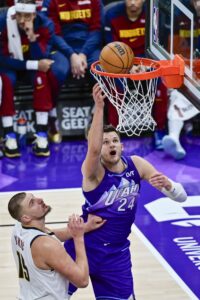 Although Bamba isn’t eligible for a two-way contract, the other two Exhibit 10 signees – Matthew Murrell and Steven Crowl – would qualify, so if they impress in the next week or two, it’s possible the Jazz will make a change to its two-way slots. While Oscar Tshiebwe and John Tonje signed this offseason, Elijah Harkless is a holdover from last season, which could put his roster spot more at risk.
Although Bamba isn’t eligible for a two-way contract, the other two Exhibit 10 signees – Matthew Murrell and Steven Crowl – would qualify, so if they impress in the next week or two, it’s possible the Jazz will make a change to its two-way slots. While Oscar Tshiebwe and John Tonje signed this offseason, Elijah Harkless is a holdover from last season, which could put his roster spot more at risk.
Finally, Kessler looks like the only legitimate extension candidate in Utah this offseason, but a recent report indicated that the two sides aren’t expected to agree to terms before the season begins.
It sounds like the Jazz would be open to getting something done, but only if the terms are very team-friendly. Otherwise, the club would prefer to head into next offseason with Kessler’s relatively modest $14.9MM cap hold in place of what would likely be a bigger first-year salary on a new extension. That will allow the Jazz to maximize their cap room.
For his part, Kessler acknowledged on media day that the situation is somewhat frustrating. It’s worth noting that the young center has been the subject of trade speculation for the better part of the past two seasons. Utah has set a high asking price that teams have thus far been unwilling to meet, but if the 24-year-old is upset at all by how his contract situation is playing out, could the front office become more open to making a deal before February’s deadline? I’m not sure that’s likely, but it’s still worth keeping an eye on in the coming weeks and months.
NBA 2025 Offseason Check-In: Chicago Bulls
Hoops Rumors is checking in on the 2025 offseason for all 30 NBA teams, recapping the summer’s free agent signings, trades, draft picks, departures, and more. We’ll take a look at each team’s offseason moves and consider what might still be coming before the regular season begins. Today, we’re focusing on the Chicago Bulls.
Free agent signings
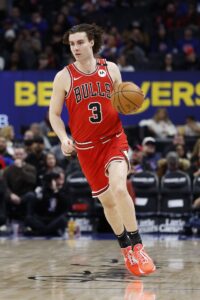 Josh Giddey: Four years, $100,000,000. Re-signed using Bird rights.
Josh Giddey: Four years, $100,000,000. Re-signed using Bird rights.- Tre Jones: Three years, $24,000,000. Third-year team option. Re-signed using Bird rights.
- Caleb Grill: One year, minimum salary. Non-guaranteed (Exhibit 10). Signed using minimum salary exception.
- Note: Grill has since been waived.
- Mouhamadou Gueye: One year, minimum salary. Non-guaranteed (Exhibit 10). Signed using minimum salary exception.
- Wooga Poplar: One year, minimum salary. Non-guaranteed (Exhibit 10). Signed using minimum salary exception.
- Note: Poplar has since been waived.
Trades
- Acquired the draft rights to Lachlan Olbrich (No. 55 pick) in the 2025 draft and cash ($2.5MM) from the Lakers in exchange for the draft rights to Rocco Zikarsky (No. 45 pick).
- Acquired Isaac Okoro from the Cavaliers in exchange for Lonzo Ball.
Draft picks
- 1-12: Noa Essengue
- Signed to rookie scale contract (four years, $25,333,943).
- 2-55: Lachlan Olbrich
- Signed to two-way contract.
Two-way signings
- Yuki Kawamura
- One year, $85,300 partial guarantee.
- Emanuel Miller
- One year, $85,300 partial guarantee.
- Lachlan Olbrich
- One year, $85,300 partial guarantee.
Departed/unsigned free agents
- Talen Horton-Tucker (Fenerbahce)
- E.J. Liddell (Nets)
Other roster moves
- Waived Jahmir Young (two-way contract).
Salary cap situation
- Operating over the cap ($154.6MM) and below the luxury tax line ($187.9MM).
- Carrying approximately $174.3MM in salary.
- Hard-capped at $195,945,000.
- Full non-taxpayer mid-level exception ($14,104,000) available.
- Full bi-annual exception ($5,134,000) available.
- One traded player exception available (worth $6,186,573).
The offseason so far
The Bulls underwent some major roster changes during the 2024 offseason, when they sent Alex Caruso to Oklahoma City and signed-and-traded DeMar DeRozan to Sacramento, and at the 2025 trade deadline, when they completed a three-team blockbuster that send Zach LaVine to the Kings and returned veterans Tre Jones, Kevin Huerter, and Zach Collins, along with complete control of the team’s 2025 first-round pick.
As a result of all that activity in the previous 12 months, the 2025 offseason was relatively quiet by comparison. With many of the club’s highest-paid players – Huerter, Collins, Nikola Vucevic, Coby White, Ayo Dosunmu, and Jevon Carter – on expiring contracts in 2025/26, Chicago could have been very active on the trade market, seeking new homes for those guys while potentially taking on some multiyear deals.
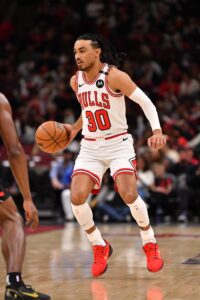 Instead, the Bulls hung onto all six of those players, and while they did add some multiyear money to their cap in free agency and on the trade market, the primary order of business this summer was keeping the current roster intact by re-signing their own free agents.
Instead, the Bulls hung onto all six of those players, and while they did add some multiyear money to their cap in free agency and on the trade market, the primary order of business this summer was keeping the current roster intact by re-signing their own free agents.
That effort began during the first few hours of free agency on June 30, when the Bulls struck a deal to re-sign Jones to a three-year, $24MM contract that includes a third-year team option. Bulls head coach Billy Donovan repeatedly lauded the veteran point guard during the final months of last season for his high basketball IQ and his knack for making winning plays, so it didn’t come as a huge surprise that the front office made it a priority to re-sign him at a price that makes sense for a backup point guard.
The Bulls’ other top free agent was also a point guard, but it took much longer for the club to reach an agreement with Josh Giddey, one of four restricted free agents whose standoffs extended well into September. Giddey reportedly came into the summer seeking a $30MM annual salary, while the Bulls initially wanted to do a deal in the neighborhood of $20MM per year. The two sides eventually compromised right in the middle — Giddey signed a four-year, $100MM contract that is fully guaranteed, with no incentives or options, and features a flat structure, with annual cap hits of $25MM.
While it’s a little more than the Bulls wanted to pay, it looks like a pretty good deal for the team. Among NBA starting point guards, Giddey’s $25MM annual salary is on the low end, and he should be entering his prime during the next four years, which will be his age 23-to-26 seasons. The former sixth overall pick hit his stride after Chicago traded LaVine in February, averaging 21.2 points, 10.7 rebounds, 9.3 assists, and 1.5 steals per game with a .500/.457/.809 shooting line after the All-Star break.
With Giddey and Jones back under contract, the Bulls were going to have a major logjam in the backcourt, with White, Dosunmu, and Lonzo Ball also expected to play rotation roles and Carter buried on the depth chart. Rather than bringing them all back, Chicago made an effort to balance its rotation a little by trading Ball straight up to the Cavaliers for Isaac Okoro.
Drafted one spot after No. 4 overall pick Patrick Williams in 2020, Okoro – like Williams – hasn’t developed into an impact wing during his first five years in the NBA. But he has shown the ability to be an effective three-and-D rotation player, knocking down at least 36.3% of his outside shots during each of the past three seasons while handling tough defensive assignments in Cleveland.
Okoro has two guaranteed years left on his contract, while Ball’s deal includes a team option for 2026/27, so the trade represented a rare instance of the Bulls cutting into their flexibility for next summer. However, the team still has more than $90MM in expiring player salaries coming off the books in 2026, so the front office will have the ability to go in a number of different directions with the roster at February’s trade deadline and/or next offseason.
Besides Okoro, the one notable newcomer to the roster is 12th overall pick Noa Essengue, an athletic, versatile forward who will be one of the NBA’s youngest players this season — he won’t turn 19 until December. As such, it’s probably not realistic to expect much from Essengue as a rookie, but if he shows some promise and 2024 lottery pick Matas Buzelis continues to make positive strides, the Bulls could have a couple solid building blocks at forward.
Up next
After officially re-signing Giddey last week, the Bulls are at 15 players on guaranteed contracts. They’ve also filled all three of their two-way slots. That doesn’t mean those 18 players are all assured of spots on the opening night roster. Two-way deals, in particular, can be fleeting, since the guaranteed money is so modest and doesn’t count against the cap at all, and there are plenty of trade candidates on the standard roster.
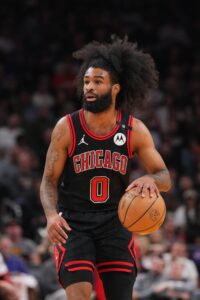 Still, I wouldn’t anticipate major changes to the current group during the preseason. The Bulls are more likely to focus on possible extension candidates, with White, Dosunmu, Vucevic, and Dalen Terry among the many players eligible.
Still, I wouldn’t anticipate major changes to the current group during the preseason. The Bulls are more likely to focus on possible extension candidates, with White, Dosunmu, Vucevic, and Dalen Terry among the many players eligible.
White, who averaged a career-high 20.4 points per game last season and thrived alongside Giddey following the LaVine trade, would be the Bulls’ top extension candidate, but the team is limited to offering him a deal that maxes out at approximately $87MM over four years. He’ll be seeking a more lucrative payday and has reportedly informed the team he doesn’t plan to sign a new contract until he reaches free agency, at which point his maximum contract would increase substantially.
Vucevic also probably isn’t a realistic candidate for a new contract. Many Bulls fans likely expected him to be traded by now, which could still happen by February 5, but even if he plays out the season with the team, the center’s days in Chicago appear numbered.
Terry played a more consistent role in 2024/25, but it doesn’t feel as if he’s shown enough in his first three NBA seasons to warrant a commitment from the team a year ahead of his free agency. Unless he takes another real step forward in ’25/26, he’s at risk of not getting a qualifying offer next summer to make him a restricted free agent.
Huerter and Collins are among the Bulls’ other extension-eligible players, but to me, Dosunmu looks like the only one with a real chance to sign a new contract before opening night. Like White, he faces a limit of about $87MM over four years, but his next deal figures to come in well below that. While he’s a solid defender, Dosunmu is more of a complementary piece on offense, having set career highs with 12.3 points and 4.5 assists per game this past season.
With Giddey and Jones back on multiyear contracts and a potential deal for White on the horizon next July, you could make a case that Dosunmu is more of a luxury than a necessity for the Bulls. But he’s a Chicago native who has been one of this front office’s better draft finds, and locking him up to an extension would give the team some insurance in the event that White doesn’t stick around beyond this season. Dosunmu will be extension-eligible all season long, so there’s no urgency to get something done in the coming weeks, but it wouldn’t surprise me if the two sides begin to discuss a potential deal.
NBA 2025 Offseason Check-In: Phoenix Suns
Hoops Rumors is checking in on the 2025 offseason for all 30 NBA teams, recapping the summer’s free agent signings, trades, draft picks, departures, and more. We’ll take a look at each team’s offseason moves and consider what might still be coming before the regular season begins. Today, we’re focusing on the Phoenix Suns.
Free agent signings
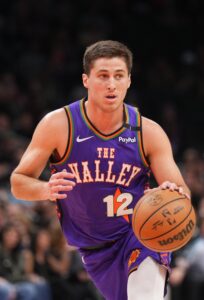 Collin Gillespie: One year, minimum salary. Re-signed using minimum salary exception.
Collin Gillespie: One year, minimum salary. Re-signed using minimum salary exception.- Nigel Hayes-Davis: One year, minimum salary. Signed using minimum salary exception.
- Jared Butler: One year, minimum salary. Non-guaranteed (Exhibit 9). Signed using minimum salary exception.
- Damion Baugh: One year, minimum salary. Non-guaranteed (Exhibit 10). Signed using minimum salary exception.
- David Duke Jr.: One year, minimum salary. Non-guaranteed (Exhibit 10). Signed using minimum salary exception.
- Tyrese Samuel: One year, minimum salary. Non-guaranteed (Exhibit 10). Signed using minimum salary exception.
- Alex Schumacher: One year, minimum salary. Non-guaranteed (Exhibit 10). Signed using minimum salary exception.
- Note: Schumacher has since been waived.
- Jaden Shackelford: One year, minimum salary. Non-guaranteed (Exhibit 10). Signed using minimum salary exception.
- Note: Shackelford has since been waived.
Trades
- Acquired Mark Williams and their own 2029 second-round pick from the Hornets in exchange for Vasilije Micic, the draft rights to Liam McNeeley (No. 29 pick), and either the Timberwolves’ (top-five protected), Cavaliers’, or Jazz’s 2029 first-round pick (whichever is least favorable).
- Note: The Suns had traded the Hornets their 2029 second-round pick in a previous deal.
- Acquired Jalen Green (from Rockets), Dillon Brooks (from Rockets), Daeqwon Plowden (two-way; from Hawks), the draft rights to Khaman Maluach (No. 10 pick; from Rockets), the draft rights to Rasheer Fleming (No. 31 pick; from Timberwolves), the draft rights to Koby Brea (No. 41 pick; from Warriors), and either the Thunder’s, Mavericks’, or Sixers’ 2026 second-round (whichever is second-most favorable; from Rockets) in a seven-team trade in exchange for Kevin Durant (to Rockets), the draft rights to Alex Toohey (No. 52 pick; to Warriors), either the Warriors’ or Nuggets’ 2026 second-round pick (whichever is least favorable; to Timberwolves), and either the Suns’ or Rockets’ 2032 second-round pick (whichever is most favorable; to Timberwolves).
- Note: Plowden was subsequently waived.
Draft picks
- 1-10: Khaman Maluach
- Signed to rookie scale contract (four years, $27,386,799).
- 2-31: Rasheer Fleming
- Signed to four-year, $8,685,386 contract. First three years guaranteed. Fourth-year team option.
- 2-41: Koby Brea
- Signed to two-way contract.
Two-way signings
- Koby Brea
- One year, $85,300 partial guarantee (will increase to $318,218 at start of regular season).
- CJ Huntley
- Two years, $85,300 partial guarantee (will increase to $318,218 at start of regular season); second year non-guaranteed (will increase to maximum two-way protection amount on July 10 and to 50% at start of regular season).
- Isaiah Livers
- One year, $85,300 partial guarantee (will increase to $318,218 at start of regular season).
Departed/unsigned free agents
- Bol Bol (unsigned)
- Jalen Bridges (Celtics)
- Tyus Jones (Magic)
- Damion Lee (Ironi Ness Ziona)
- Monte Morris (unsigned)
- Mason Plumlee (Hornets)
- TyTy Washington Jr. (Clippers)
Other roster moves
- Signed Devin Booker to a two-year, $88,762,440 veteran contract extension that begins in 2028/29. Projected value of $145,760,888. Includes second-year player option.
- Bought out and stretched Bradley Beal (gave up $13,879,830 of $110,794,880 total guaranteed salary).
- Claimed Jordan Goodwin off waivers from the Lakers.
- Waived Cody Martin (non-guaranteed contract).
Salary cap situation
- Operating over the cap ($154.6MM) and above the luxury tax line ($187.9MM).
- Carrying approximately $187.9MM in salary.
- No hard cap.
- Full non-taxpayer mid-level exception ($14,104,000) available.
- Full bi-annual exception ($5,134,000) available.
- Three traded player exceptions available (largest worth $3,628,720).
The offseason so far
 The Suns fell short of expectations in 2023/24, their first season with Kevin Durant, Devin Booker, and Bradley Beal on the roster together, earning the No. 6 seed in the Western Conference and getting swept out of the first round of the playoffs by the Timberwolves.
The Suns fell short of expectations in 2023/24, their first season with Kevin Durant, Devin Booker, and Bradley Beal on the roster together, earning the No. 6 seed in the Western Conference and getting swept out of the first round of the playoffs by the Timberwolves.
But that 49-win season actually looked pretty good in retrospect when compared to the all-out disaster that was ’24/25. Phoenix went just 36-46 last season and entered the offseason as the only NBA team that didn’t make the playoffs, didn’t make the play-in tournament, and didn’t control a lottery pick. The Suns were also the only club that made both a front office and head coaching change this spring, hiring Brian Gregory to replace general manager James Jones and Jordan Ott to replace coach Mike Budenholzer.
Injuries were a recurring problem for the Suns’ “big three,” as Durant missed 20 games in 2024/25 while Beal was sidelined for 29. But the team wasn’t good even when all three players were healthy and available — Durant, Booker, and Beal had a -4.1 net rating during the 667 minutes they shared the court last season. It simply wasn’t the right fit.
That meant the Suns headed into the summer with major decisions to make on all three players. They ended up taking a different route with each one of them, with Booker as the lone keeper. Not only did the Suns hang onto the star guard, but they gave him a maximum-salary contract extension, despite the fact that he still had three years left on his current deal. The new two-year contract will start in 2028/29 and projects to be worth well over $70MM annually, with a player option in ’29/30.
It seemed like an unnecessarily early commitment for the Suns to make, especially on the heels of a dysfunctional season in which Booker’s three-point percentage dipped to 33.2%, one of the worst marks of his career. But with speculation swirling about whether it would be in the organization’s best interests to kick-start a full rebuild, the front office was determined to show it was serious about its stance against trading Booker. With the extension, the Suns made it clear they’re all-in on the four-time All-Star.
Durant, on the other hand, was one of the offseason’s most obvious trade candidates after the Suns initially opened discussions on the star forward prior to February’s deadline. The fact that Phoenix ultimately agreed to terms to send Durant to Houston didn’t come as a real surprise, though the eventual structure of the blockbuster – which expanded to include seven teams in total – was unique.
That transaction combined several separate trade agreements into a single deal, but the Suns’ haul for Durant was ultimately headlined by a handful of pieces: fifth-year guard Jalen Green, veteran wing and professional nuisance Dillon Brooks, and the draft rights to three rookies, led by No. 10 overall pick Khaman Maluach.
In retrospect, the Suns’ decision to trade Mikal Bridges, Cameron Johnson, Jae Crowder, and four unprotected first-round picks (plus a swap) for Durant at the 2023 deadline looks like a mistake. They were unable to recoup that same sort of value when they flipped him two-and-a-half years later.
But as great as Durant is, he’s entering his age-37 season and is on an expiring contract, so the Suns could’ve done a lot worse this time around. Green has averaged over 20 points per game through his first four NBA seasons and is still just 23 years old; Brooks remains one of the league’s most effective and irritating defenders; and Maluach has a chance to become the team’s long-term answer in the middle. It’s not hard to imagine a scenario in which the 2027 Rockets feel a similar regret to the 2025 Suns about the package they gave up for Durant.
One thing the Durant deal didn’t do was save the Suns money, which was a problem, since the club had the NBA’s highest payroll in 2024/25, far above the second tax apron. With a retooled roster and no more short-term championship aspirations, Phoenix wasn’t interested in maintaining such a high team salary again and took an extreme measure to address the issue, reaching a buyout agreement with Beal and waiving and stretching the two years and $97MM still left on his contract.
Rather than carrying a cap hit of $54.7MM, Beal now counts for just $19.4MM in 2025/26, a reduction of more than $35MM that nearly moved the Suns out of luxury tax territory altogether. The downside? That $19.4MM in dead money will apply to the team’s cap for each of the next five seasons, through 2029/30, putting a major dent in the front office’s flexibility going forward.
While the Bucks took a similar path with Damian Lillard, Milwaukee used the stretch provision in order to create the cap room necessary to sign Myles Turner. The Suns didn’t have a follow-up move lined up after stretching Beal, which was mostly about saving money. Phoenix does have much more room to maneuver in the short term, but the club has yet to actually take advantage of that newfound flexibility.
Although the Suns’ most significant offseason moves revolved around those three stars, they were active on other fronts too. Notably, they struck a draft-day deal to acquire center Mark Williams from the Hornets in exchange for this year’s No. 29 pick and a future first-rounder. That’s not necessarily an overpay for a 23-year-old center coming off a season in which he averaged 15 points and 10 rebounds, but the timing was a little odd, given that news of the deal broke right around the time the Suns drafted Maluach.
The rookie out of Duke, who turned 19 earlier this month, probably isn’t far enough along in his developmental process to play a major role immediately. Still, it’s hard to believe the Suns view Williams as simply a stop-gap solution at center until Maluach is ready — teams don’t give up multiple first-round picks for players if they don’t envision them as part of their future, and Williams is due to be paid this year or next (he’s currently eligible for a rookie scale extension). It will be interesting to see how the Suns manage their center position going forward.
Outside of Williams and the players they acquired in the Durant mega-deal, the Suns focused on filling out their roster with minimum-salary players. That group includes Collin Gillespie, who got a promotion from his two-way deal to a standard roster spot, and Nigel Hayes-Davis, whom the Suns brought back from Europe for his first NBA contract since he was waived by Sacramento in July 2018.
It also includes Rasheer Fleming, a rookie who was targeted by several teams heading into the second day of the draft before the Suns won the mini-sweepstakes for him by making a trade for the No. 31 overall pick. Getting younger, more athletic, and better defensively was a goal for Phoenix this summer, and drafting Fleming reflected that approach — the former Saint Joseph’s forward has a 7’5″ wingspan and averaged an impressive 1.5 blocks and 1.4 steals per game as a junior last season.
Up next
 Because he’s a free agent signing whose minimum-salary contract is subject to tax variance, Hayes-Davis counts a little more for tax purposes than he does against the salary cap, but even after taking that into account, the Suns are barely over the tax line — their 14 players on standard contracts put them into the tax by less than $300K.
Because he’s a free agent signing whose minimum-salary contract is subject to tax variance, Hayes-Davis counts a little more for tax purposes than he does against the salary cap, but even after taking that into account, the Suns are barely over the tax line — their 14 players on standard contracts put them into the tax by less than $300K.
That number would increase if Phoenix decides to carry a 15th man into the regular season. For now though, it looks like the team will probably leave an open spot on its regular season roster, with Jordan Goodwin ($200K partial guarantee) and Jared Butler (non-guaranteed Exhibit 9 contract) vying to be the 14th man alongside the team’s 13 players on fully guaranteed deals.
Goodwin’s contract structure may give him the slight edge, though the difference in marginal and the Suns should be able to duck the tax later in the season (if that’s a priority) regardless of which guard they hang onto.
Assuming the Suns keep their 13 players on guaranteed contracts, their three players on two-way deals, and one of Goodwin or Butler, the only other major preseason decisions will likely involve contract extensions. Williams, backup center Nick Richards, and Brooks are all eligible to sign new deals.
Of those three players, Williams is the most likely to get something done before opening night. Richards will remain extension-eligible all season long and probably doesn’t have a long-term future in Phoenix anyway after the club added Williams and Maluach. Brooks, meanwhile, still has two years left on his current contract, so there’s no rush to work out a new agreement with him prior to the 2026 offseason.
Williams, however, would become a restricted free agent next summer if he’s not extended this year. It’s possible the Suns are OK with that outcome. The big man has yet to play a game for his new team, and restricted free agency has favored teams over players this offseason. Still, if wouldn’t be a surprise if Williams and the Suns find a compromise both sides can live with next month. As noted above, teams typically don’t give up multiple first-round picks for players who aren’t in their long-term plans, so it’s safe to assume Phoenix would like to work out a new deal with the former Hornet sooner or later.
NBA 2025 Offseason Check-In: Charlotte Hornets
Hoops Rumors is checking in on the 2025 offseason for all 30 NBA teams, recapping the summer’s free agent signings, trades, draft picks, departures, and more. We’ll take a look at each team’s offseason moves and consider what might still be coming before the regular season begins. Today, we’re focusing on the Charlotte Hornets.
Free agent signings
 Tre Mann: Three years, $24,000,000. Third-year team option. Includes back-related injury protection. Re-signed using Bird rights.
Tre Mann: Three years, $24,000,000. Third-year team option. Includes back-related injury protection. Re-signed using Bird rights.- Spencer Dinwiddie: One year, minimum salary. Signed using minimum salary exception.
- Mason Plumlee: One year, minimum salary. Signed using minimum salary exception.
- Terrell Brown: One year, minimum salary. Non-guaranteed (Exhibit 10). Signed using minimum salary exception.
- Marcus Garrett: One year, minimum salary. Non-guaranteed (Exhibit 10). Signed using minimum salary exception.
- Keyontae Johnson: One year, minimum salary. Non-guaranteed (Exhibit 10). Signed using minimum salary exception.
- Isaih Moore: One year, minimum salary. Non-guaranteed (Exhibit 10). Signed using minimum salary exception.
- DJ Rodman: One year, minimum salary. Non-guaranteed (Exhibit 10). Signed using minimum salary exception.
- Brandon Slater: One year, minimum salary. Non-guaranteed (Exhibit 10). Signed using minimum salary exception.
Trades
- Acquired Collin Sexton and either the Jazz’s or Clippers’ 2030 second-round pick (whichever is most favorable) from the Jazz in exchange for Jusuf Nurkic.
- Acquired Vasilije Micic, the draft rights to Liam McNeeley (No. 29 pick), and either the Timberwolves’ (top-five protected), Cavaliers’, or Jazz’s 2029 first-round pick (whichever is least favorable) from the Suns in exchange for Mark Williams and the Suns’ 2029 second-round pick.
- Acquired Pat Connaughton, the Bucks’ 2031 second-round pick, and the Bucks’ 2032 second-round pick from the Bucks in exchange for Vasilije Micic.
Draft picks
- 1-4: Kon Knueppel
- Signed to rookie scale contract (four years, $45,487,013).
- 1-29: Liam McNeeley
- Signed to rookie scale contract (four years, $14,194,138).
- 2-33: Sion James
- Signed to four-year, $9,968,963 contract. First two years guaranteed. Third year non-guaranteed. Fourth-year team option.
- 2-34: Ryan Kalkbrenner
- Signed to four-year, $9,968,963 contract. First two years guaranteed. Third year non-guaranteed. Fourth-year team option.
Two-way signings
- Drew Peterson
- One year, $85,300 partial guarantee.
- Antonio Reeves
- One year, $85,300 partial guarantee.
Note: The Hornets carried over KJ Simpson on a two-way contract from 2024/25.
Departed/unsigned free agents
- Seth Curry (unsigned)
- Taj Gibson (unsigned)
- Wendell Moore Jr. (unsigned)
Other roster moves
- Waived DaQuan Jeffries (non-guaranteed contract).
- Waived Josh Okogie (non-guaranteed contract).
- Waived Damion Baugh (two-way contract).
Salary cap situation
- Operating over the cap ($154.6MM) and below the luxury tax line ($187.9MM).
- Carrying approximately $171.5MM in salary.
- Hard-capped at $195,945,000.
The offseason so far
Since taking over as the Hornets’ president of basketball operations in March of 2024, Jeff Peterson has shown little urgency to accelerate the team’s rebuilding process. Charlotte, which last appeared in the playoffs in 2016, has the NBA’s longest active postseason drought and hasn’t won a playoff series since returning to the league as an expansion team in 2004, but Peterson and his front office are showing patience as they attempt to build the roster into one capable of sustained success.
That philosophy was evident again this summer. The Hornets entered the offseason with a pretty favorable cap situation and could have used their full mid-level exception on a free agent addition while remaining comfortably below the luxury tax line. However, the front office instead focused on building through the draft and accumulating draft assets on the trade market, while the club’s only forays into free agency involved re-signing its own players or bringing in minimum-salary veterans.
 Let’s start with the draft, where the Hornets made four picks in the top 34 and subsequently signed all four players to standard contracts. With the No. 4 overall selection, Charlotte took the relatively safe route by adding Duke sharpshooter Kon Knueppel. The one-and-done wing should have a high floor as a pro, but his ceiling is probably quite a bit lower than that of Ace Bailey, who fell to Utah at No. 5.
Let’s start with the draft, where the Hornets made four picks in the top 34 and subsequently signed all four players to standard contracts. With the No. 4 overall selection, Charlotte took the relatively safe route by adding Duke sharpshooter Kon Knueppel. The one-and-done wing should have a high floor as a pro, but his ceiling is probably quite a bit lower than that of Ace Bailey, who fell to Utah at No. 5.
There’s a case to be made that the Hornets should have rolled the dice on Bailey, the player with greater star potential, but they didn’t get a chance to visit with or work out the former Rutgers standout, who was believed to be trying to steer his way to Washington at No. 6. With incumbent cornerstones LaMelo Ball and Brandon Miller coming off injury-shortened seasons, the Hornets decided to prioritize stability over a higher-risk, higher-reward option. And while Knueppel may not become a superstar, he absolutely has the chance to become one of the NBA’s very best shooters while holding his own on defense.
With the 29th, 33rd, and 34th overall picks, Charlotte drafted UConn’s Liam McNeeley, Knueppel’s former Duke teammate Sion James, and Creighton big man Ryan Kalkbrenner, respectively. Once again, the Hornets took a more conservative approach with these picks — McNeeley had been projected by draft experts to come off the board much earlier in the first round, so he was a solid value at No. 29, while James and Kalkbrenner were five-year college players who have had plenty of time to hone their games and could be ready to contribute at the NBA level right away.
Kalkbrenner, in particular, could have an immediate path to rotation minutes in a fairly thin Charlotte frontcourt. James will likely have to rely on his defense to earn him playing time, while McNeeley will have to get back on track after a poor shooting performance in his only college season. Playing alongside Ball and/or Tre Mann should benefit McNeeley in a major way after he spent his freshman year on a Huskies team that operated without a true point guard.
The Hornets acquired the pick they used on McNeeley as part of a trade sending Mark Williams to Phoenix. It was actually the second time the front office had agreed to trade Williams — a deal with the Lakers at last season’s trade deadline fell through due to concerns about his physical. Whether the Hornets share those concerns about the big man’ long-term health or whether they just weren’t especially bullish about his long-term upside, it was clear he was no longer part of their future plans.
Taking into account a subsequent trade involving Vasilije Micic, who was sent from Phoenix to Charlotte in the Williams deal and then flipped to Milwaukee, the Hornets’ total haul for Williams consisted of McNeeley, Pat Connaughton, a 2029 first-round pick, and a future second-round pick (they gave up a second-rounder in the Suns trade but got two back in their deal with the Bucks).
Given that the first-rounder includes “least favorable” language and seems likely to land in the 20s, the return might not be as strong as the package Charlotte nearly acquired from the Lakers at the trade deadline (Dalton Knecht, a future unprotected first-rounder, and a first-round swap). But if McNeeley can develop into a reliable rotation player, it should end up looking fine for the Hornets, who would have had to pay Williams on his second contract beginning in 2026 if they’d hung onto him.
The Hornets’ other offseason trade wasn’t as significant as the one involving Williams, but it was curious for a couple reasons. For one, I’m not sure how Charlotte managed to extract a second-round pick from Utah while swapping Jusuf Nurkic for Collin Sexton, given that both players are on nearly identical expiring contracts and Nurkic – who is older than Sexton by five years – saw his playing time and production fall off last season. That was good work by the front office.
On the other hand, the Hornets’ backcourt is far more crowded than its center spot, so the trade wasn’t an obvious fit from a depth chart perspective. But with Ball and Mann both coming off injuries, acquiring another guard who can handle the ball made some amount of sense for Charlotte.
Speaking of Mann, even though he was limited to just 13 games last season due to a back injury, he was rewarded in free agency with a three-year, $24MM contract. The deal includes a third-year team option and some injury protection for the Hornets in the event that same back issue resurfaces, but it’s still a nice payday for Mann, who was productive (12.6 PPG, 4.5 APG, .446/.377/.797 shooting) in 41 games for Charlotte across parts of two seasons before being sidelined.
The Hornets brought in some additional depth at the point and in the middle by signing free agents Spencer Dinwiddie and Mason Plumlee to minimum-salary contracts. Neither Dinwiddie nor Plumlee is likely to play a starring role in Charlotte, but they’re reliable veterans who can give the team 15-20 minutes per night if needed.
Up next
 Even after waiving DaQuan Jeffries earlier this month, the Hornets have a bit of a roster crunch to deal with before the regular season begins, with 16 players on guaranteed contracts and Moussa Diabate (on a non-guaranteed contract) looking likely to make the roster.
Even after waiving DaQuan Jeffries earlier this month, the Hornets have a bit of a roster crunch to deal with before the regular season begins, with 16 players on guaranteed contracts and Moussa Diabate (on a non-guaranteed contract) looking likely to make the roster.
If Charlotte chooses to simply waive two players in order to set its 15-man regular season roster, Connaughton and former first-round pick Nick Smith Jr. look like the odd men out to me.
Diabate’s non-guaranteed contract would normally make him an obvious release candidate, but he gave the team good minutes last season and could even have a path to a starting role this fall, with just Kalkbrenner and Plumlee as his primary competition at center. Dinwiddie and Plumlee are on small expiring contracts, but probably wouldn’t have been given guaranteed salaries two months ago if the plan was to waive either of them.
If the Hornets want to hang onto Connaughton’s expiring contract for midseason trade purposes or if they liked what they saw from Smith down the stretch last season, maybe they try to make a trade to open up a spot to keep one of them. But most teams won’t be looking to shake up their rosters during the preseason, and there are only so many legitimate trade candidates on the Hornets’ roster. Josh Green and Grant Williams could be a couple to watch.
Green and Williams are two of the Hornets’ players eligible for contract extensions, along with Sexton and Connaughton, but I’d be surprised if the team completes any extensions before the season tips off. The front office likely wants to keep its cap sheet relatively clean going forward, and none of those four players are obvious long-term keepers for the organization.